Medication Safety and Administration Practices
VerifiedAdded on 2020/04/21
|18
|4875
|83
AI Summary
This assignment delves into the crucial topic of medication safety within healthcare settings. It examines National Institute for Health and Care Excellence (NICE) guidelines on administering medications, emphasizing the importance of adherence to these standards to prevent adverse events. The analysis also considers reports from the National Patient Safety Agency (NPSA) that underscore the frequency and severity of medication errors, highlighting the need for robust safety protocols. Furthermore, the assignment explores various strategies to mitigate medication errors, including interventions during anesthesia and surgery, human factors considerations, and the role of patient and public involvement in quality improvement.
Contribute Materials
Your contribution can guide someone’s learning journey. Share your
documents today.
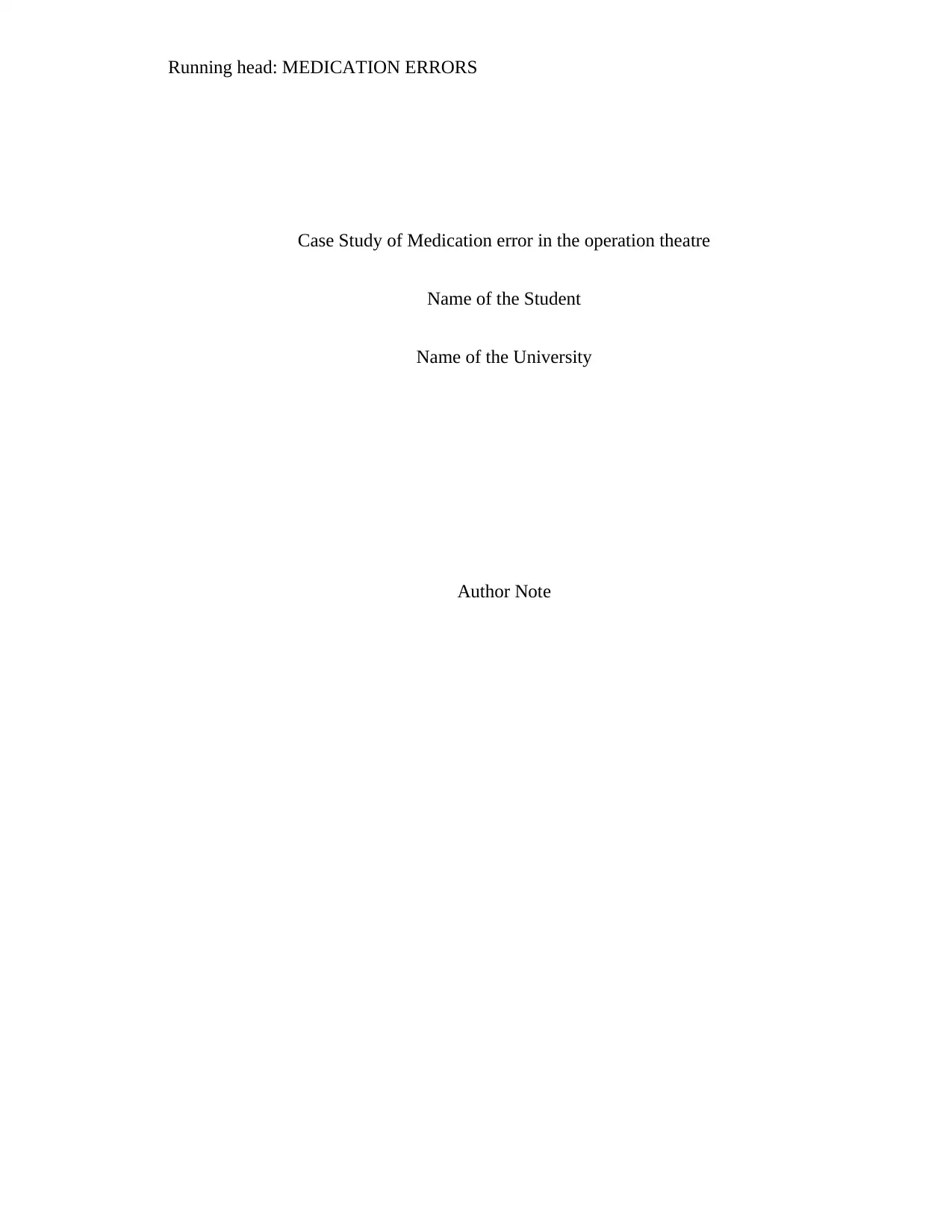
Running head: MEDICATION ERRORS
Case Study of Medication error in the operation theatre
Name of the Student
Name of the University
Author Note
Case Study of Medication error in the operation theatre
Name of the Student
Name of the University
Author Note
Secure Best Marks with AI Grader
Need help grading? Try our AI Grader for instant feedback on your assignments.
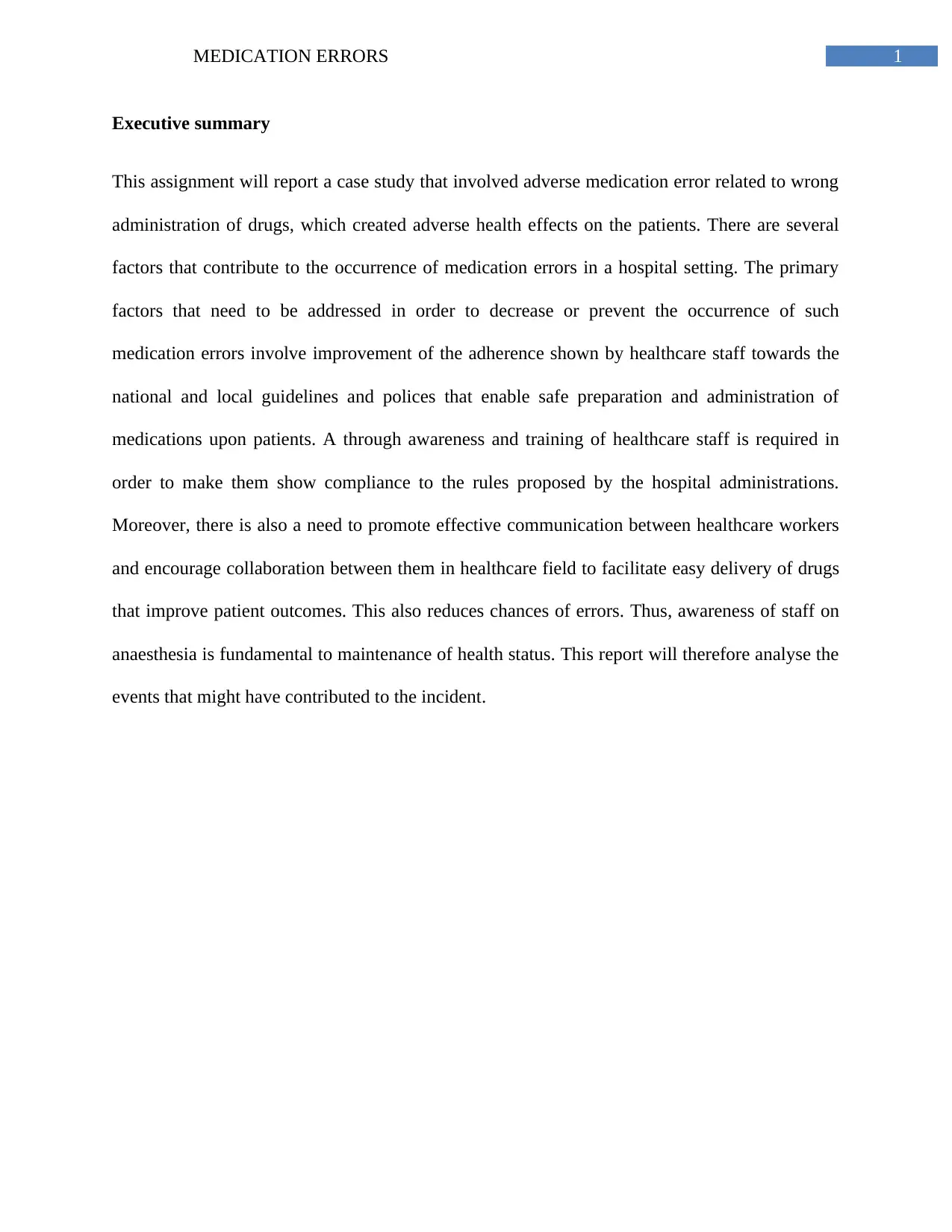
MEDICATION ERRORS 1
Executive summary
This assignment will report a case study that involved adverse medication error related to wrong
administration of drugs, which created adverse health effects on the patients. There are several
factors that contribute to the occurrence of medication errors in a hospital setting. The primary
factors that need to be addressed in order to decrease or prevent the occurrence of such
medication errors involve improvement of the adherence shown by healthcare staff towards the
national and local guidelines and polices that enable safe preparation and administration of
medications upon patients. A through awareness and training of healthcare staff is required in
order to make them show compliance to the rules proposed by the hospital administrations.
Moreover, there is also a need to promote effective communication between healthcare workers
and encourage collaboration between them in healthcare field to facilitate easy delivery of drugs
that improve patient outcomes. This also reduces chances of errors. Thus, awareness of staff on
anaesthesia is fundamental to maintenance of health status. This report will therefore analyse the
events that might have contributed to the incident.
Executive summary
This assignment will report a case study that involved adverse medication error related to wrong
administration of drugs, which created adverse health effects on the patients. There are several
factors that contribute to the occurrence of medication errors in a hospital setting. The primary
factors that need to be addressed in order to decrease or prevent the occurrence of such
medication errors involve improvement of the adherence shown by healthcare staff towards the
national and local guidelines and polices that enable safe preparation and administration of
medications upon patients. A through awareness and training of healthcare staff is required in
order to make them show compliance to the rules proposed by the hospital administrations.
Moreover, there is also a need to promote effective communication between healthcare workers
and encourage collaboration between them in healthcare field to facilitate easy delivery of drugs
that improve patient outcomes. This also reduces chances of errors. Thus, awareness of staff on
anaesthesia is fundamental to maintenance of health status. This report will therefore analyse the
events that might have contributed to the incident.
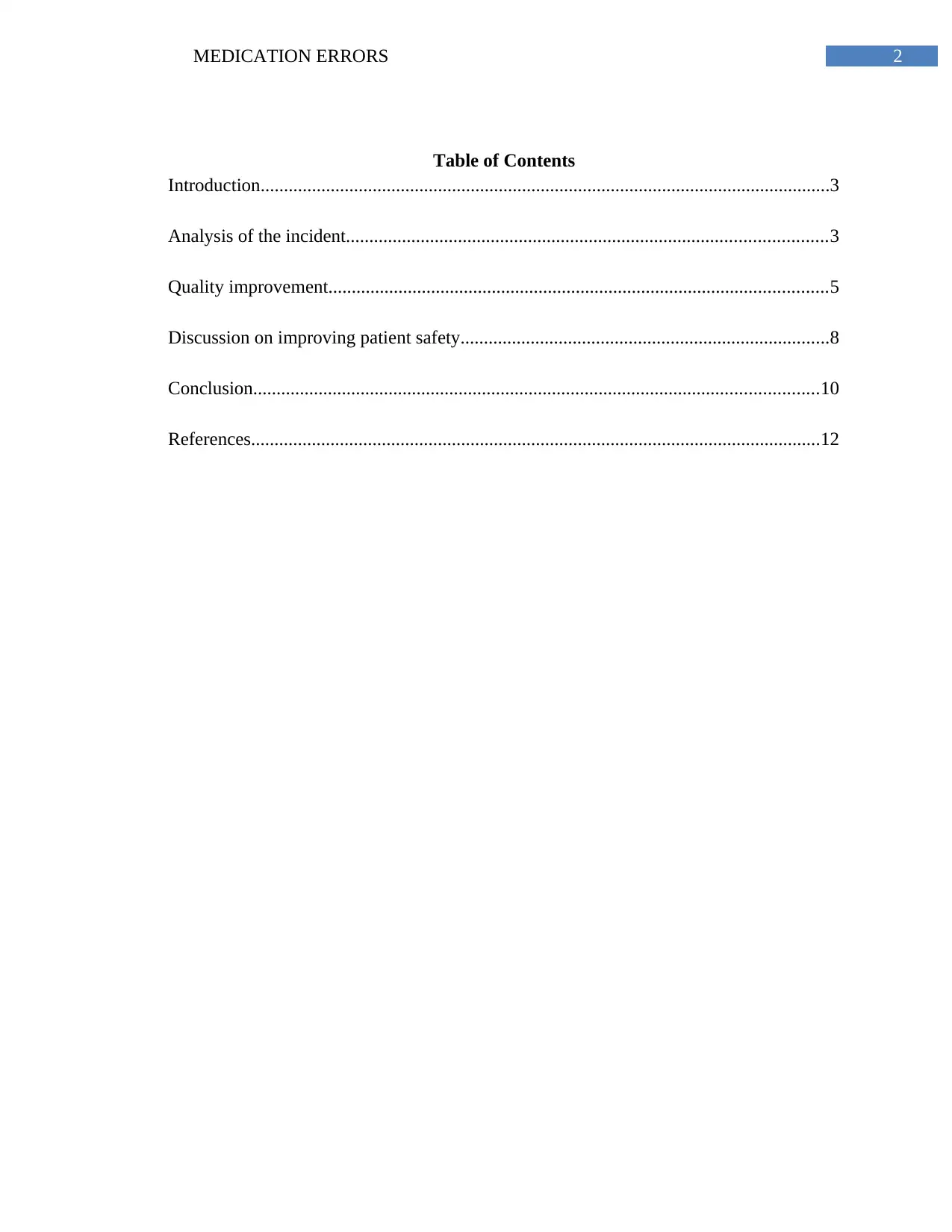
MEDICATION ERRORS 2
Table of Contents
Introduction..........................................................................................................................3
Analysis of the incident.......................................................................................................3
Quality improvement...........................................................................................................5
Discussion on improving patient safety...............................................................................8
Conclusion.........................................................................................................................10
References..........................................................................................................................12
Table of Contents
Introduction..........................................................................................................................3
Analysis of the incident.......................................................................................................3
Quality improvement...........................................................................................................5
Discussion on improving patient safety...............................................................................8
Conclusion.........................................................................................................................10
References..........................................................................................................................12
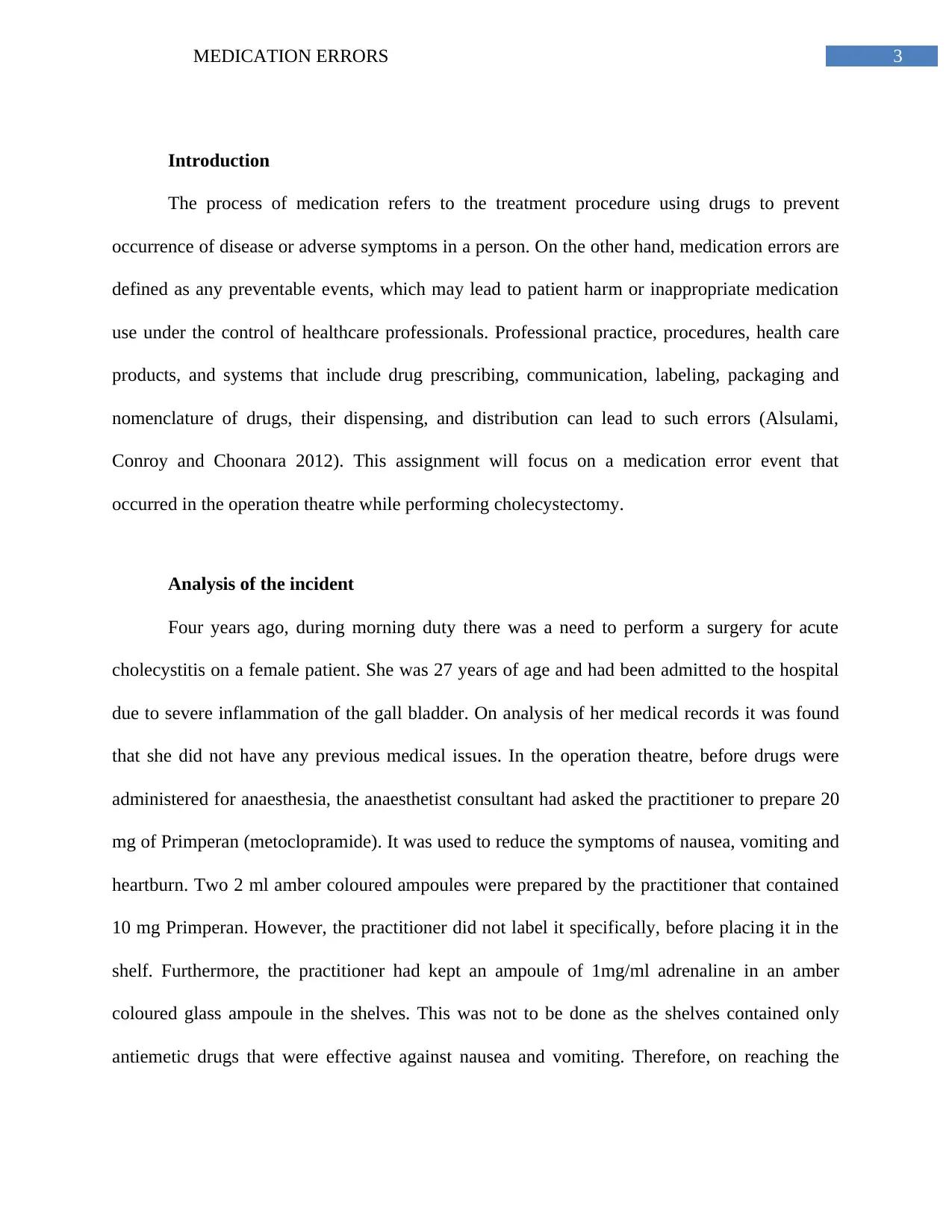
MEDICATION ERRORS 3
Introduction
The process of medication refers to the treatment procedure using drugs to prevent
occurrence of disease or adverse symptoms in a person. On the other hand, medication errors are
defined as any preventable events, which may lead to patient harm or inappropriate medication
use under the control of healthcare professionals. Professional practice, procedures, health care
products, and systems that include drug prescribing, communication, labeling, packaging and
nomenclature of drugs, their dispensing, and distribution can lead to such errors (Alsulami,
Conroy and Choonara 2012). This assignment will focus on a medication error event that
occurred in the operation theatre while performing cholecystectomy.
Analysis of the incident
Four years ago, during morning duty there was a need to perform a surgery for acute
cholecystitis on a female patient. She was 27 years of age and had been admitted to the hospital
due to severe inflammation of the gall bladder. On analysis of her medical records it was found
that she did not have any previous medical issues. In the operation theatre, before drugs were
administered for anaesthesia, the anaesthetist consultant had asked the practitioner to prepare 20
mg of Primperan (metoclopramide). It was used to reduce the symptoms of nausea, vomiting and
heartburn. Two 2 ml amber coloured ampoules were prepared by the practitioner that contained
10 mg Primperan. However, the practitioner did not label it specifically, before placing it in the
shelf. Furthermore, the practitioner had kept an ampoule of 1mg/ml adrenaline in an amber
coloured glass ampoule in the shelves. This was not to be done as the shelves contained only
antiemetic drugs that were effective against nausea and vomiting. Therefore, on reaching the
Introduction
The process of medication refers to the treatment procedure using drugs to prevent
occurrence of disease or adverse symptoms in a person. On the other hand, medication errors are
defined as any preventable events, which may lead to patient harm or inappropriate medication
use under the control of healthcare professionals. Professional practice, procedures, health care
products, and systems that include drug prescribing, communication, labeling, packaging and
nomenclature of drugs, their dispensing, and distribution can lead to such errors (Alsulami,
Conroy and Choonara 2012). This assignment will focus on a medication error event that
occurred in the operation theatre while performing cholecystectomy.
Analysis of the incident
Four years ago, during morning duty there was a need to perform a surgery for acute
cholecystitis on a female patient. She was 27 years of age and had been admitted to the hospital
due to severe inflammation of the gall bladder. On analysis of her medical records it was found
that she did not have any previous medical issues. In the operation theatre, before drugs were
administered for anaesthesia, the anaesthetist consultant had asked the practitioner to prepare 20
mg of Primperan (metoclopramide). It was used to reduce the symptoms of nausea, vomiting and
heartburn. Two 2 ml amber coloured ampoules were prepared by the practitioner that contained
10 mg Primperan. However, the practitioner did not label it specifically, before placing it in the
shelf. Furthermore, the practitioner had kept an ampoule of 1mg/ml adrenaline in an amber
coloured glass ampoule in the shelves. This was not to be done as the shelves contained only
antiemetic drugs that were effective against nausea and vomiting. Therefore, on reaching the
Secure Best Marks with AI Grader
Need help grading? Try our AI Grader for instant feedback on your assignments.
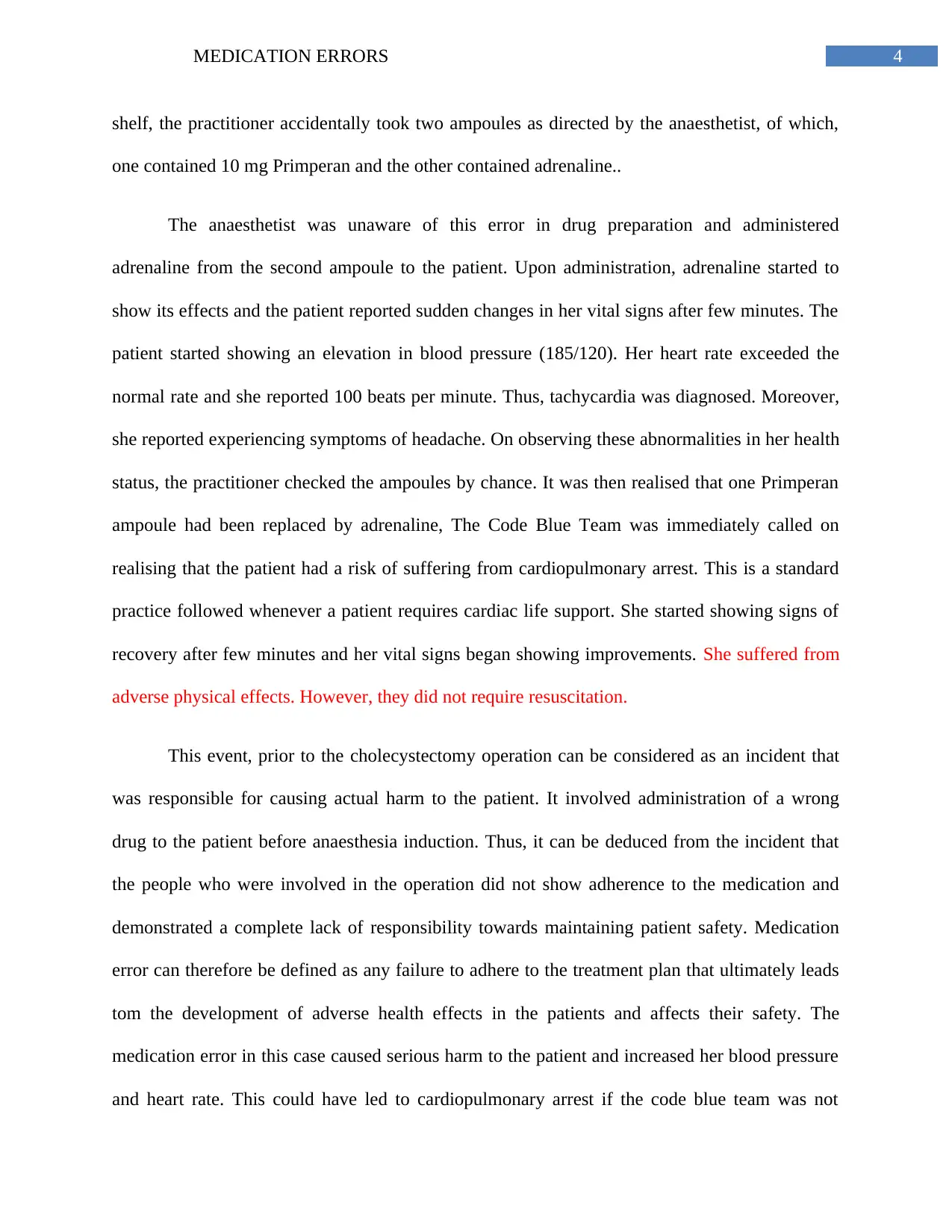
MEDICATION ERRORS 4
shelf, the practitioner accidentally took two ampoules as directed by the anaesthetist, of which,
one contained 10 mg Primperan and the other contained adrenaline..
The anaesthetist was unaware of this error in drug preparation and administered
adrenaline from the second ampoule to the patient. Upon administration, adrenaline started to
show its effects and the patient reported sudden changes in her vital signs after few minutes. The
patient started showing an elevation in blood pressure (185/120). Her heart rate exceeded the
normal rate and she reported 100 beats per minute. Thus, tachycardia was diagnosed. Moreover,
she reported experiencing symptoms of headache. On observing these abnormalities in her health
status, the practitioner checked the ampoules by chance. It was then realised that one Primperan
ampoule had been replaced by adrenaline, The Code Blue Team was immediately called on
realising that the patient had a risk of suffering from cardiopulmonary arrest. This is a standard
practice followed whenever a patient requires cardiac life support. She started showing signs of
recovery after few minutes and her vital signs began showing improvements. She suffered from
adverse physical effects. However, they did not require resuscitation.
This event, prior to the cholecystectomy operation can be considered as an incident that
was responsible for causing actual harm to the patient. It involved administration of a wrong
drug to the patient before anaesthesia induction. Thus, it can be deduced from the incident that
the people who were involved in the operation did not show adherence to the medication and
demonstrated a complete lack of responsibility towards maintaining patient safety. Medication
error can therefore be defined as any failure to adhere to the treatment plan that ultimately leads
tom the development of adverse health effects in the patients and affects their safety. The
medication error in this case caused serious harm to the patient and increased her blood pressure
and heart rate. This could have led to cardiopulmonary arrest if the code blue team was not
shelf, the practitioner accidentally took two ampoules as directed by the anaesthetist, of which,
one contained 10 mg Primperan and the other contained adrenaline..
The anaesthetist was unaware of this error in drug preparation and administered
adrenaline from the second ampoule to the patient. Upon administration, adrenaline started to
show its effects and the patient reported sudden changes in her vital signs after few minutes. The
patient started showing an elevation in blood pressure (185/120). Her heart rate exceeded the
normal rate and she reported 100 beats per minute. Thus, tachycardia was diagnosed. Moreover,
she reported experiencing symptoms of headache. On observing these abnormalities in her health
status, the practitioner checked the ampoules by chance. It was then realised that one Primperan
ampoule had been replaced by adrenaline, The Code Blue Team was immediately called on
realising that the patient had a risk of suffering from cardiopulmonary arrest. This is a standard
practice followed whenever a patient requires cardiac life support. She started showing signs of
recovery after few minutes and her vital signs began showing improvements. She suffered from
adverse physical effects. However, they did not require resuscitation.
This event, prior to the cholecystectomy operation can be considered as an incident that
was responsible for causing actual harm to the patient. It involved administration of a wrong
drug to the patient before anaesthesia induction. Thus, it can be deduced from the incident that
the people who were involved in the operation did not show adherence to the medication and
demonstrated a complete lack of responsibility towards maintaining patient safety. Medication
error can therefore be defined as any failure to adhere to the treatment plan that ultimately leads
tom the development of adverse health effects in the patients and affects their safety. The
medication error in this case caused serious harm to the patient and increased her blood pressure
and heart rate. This could have led to cardiopulmonary arrest if the code blue team was not
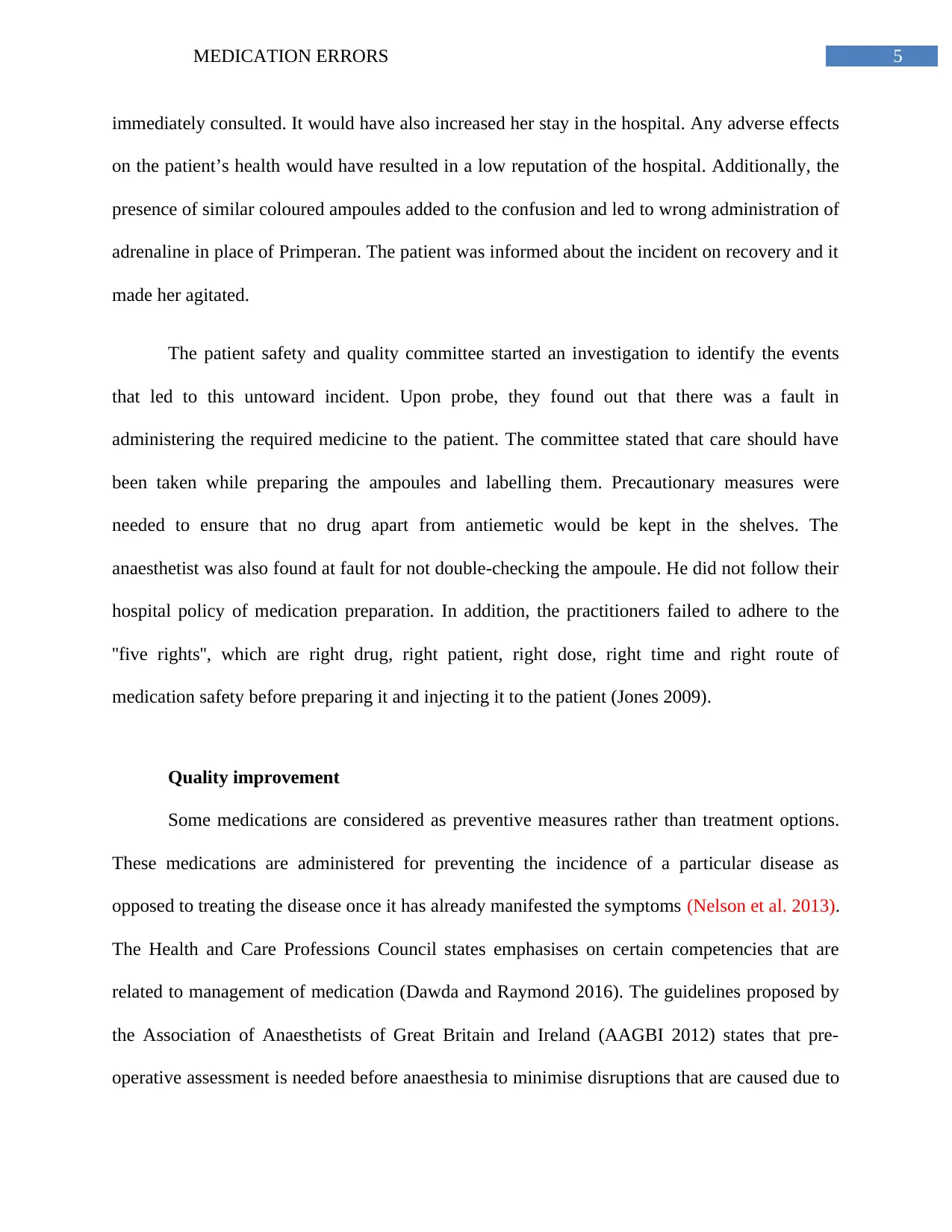
MEDICATION ERRORS 5
immediately consulted. It would have also increased her stay in the hospital. Any adverse effects
on the patient’s health would have resulted in a low reputation of the hospital. Additionally, the
presence of similar coloured ampoules added to the confusion and led to wrong administration of
adrenaline in place of Primperan. The patient was informed about the incident on recovery and it
made her agitated.
The patient safety and quality committee started an investigation to identify the events
that led to this untoward incident. Upon probe, they found out that there was a fault in
administering the required medicine to the patient. The committee stated that care should have
been taken while preparing the ampoules and labelling them. Precautionary measures were
needed to ensure that no drug apart from antiemetic would be kept in the shelves. The
anaesthetist was also found at fault for not double-checking the ampoule. He did not follow their
hospital policy of medication preparation. In addition, the practitioners failed to adhere to the
''five rights'', which are right drug, right patient, right dose, right time and right route of
medication safety before preparing it and injecting it to the patient (Jones 2009).
Quality improvement
Some medications are considered as preventive measures rather than treatment options.
These medications are administered for preventing the incidence of a particular disease as
opposed to treating the disease once it has already manifested the symptoms (Nelson et al. 2013).
The Health and Care Professions Council states emphasises on certain competencies that are
related to management of medication (Dawda and Raymond 2016). The guidelines proposed by
the Association of Anaesthetists of Great Britain and Ireland (AAGBI 2012) states that pre-
operative assessment is needed before anaesthesia to minimise disruptions that are caused due to
immediately consulted. It would have also increased her stay in the hospital. Any adverse effects
on the patient’s health would have resulted in a low reputation of the hospital. Additionally, the
presence of similar coloured ampoules added to the confusion and led to wrong administration of
adrenaline in place of Primperan. The patient was informed about the incident on recovery and it
made her agitated.
The patient safety and quality committee started an investigation to identify the events
that led to this untoward incident. Upon probe, they found out that there was a fault in
administering the required medicine to the patient. The committee stated that care should have
been taken while preparing the ampoules and labelling them. Precautionary measures were
needed to ensure that no drug apart from antiemetic would be kept in the shelves. The
anaesthetist was also found at fault for not double-checking the ampoule. He did not follow their
hospital policy of medication preparation. In addition, the practitioners failed to adhere to the
''five rights'', which are right drug, right patient, right dose, right time and right route of
medication safety before preparing it and injecting it to the patient (Jones 2009).
Quality improvement
Some medications are considered as preventive measures rather than treatment options.
These medications are administered for preventing the incidence of a particular disease as
opposed to treating the disease once it has already manifested the symptoms (Nelson et al. 2013).
The Health and Care Professions Council states emphasises on certain competencies that are
related to management of medication (Dawda and Raymond 2016). The guidelines proposed by
the Association of Anaesthetists of Great Britain and Ireland (AAGBI 2012) states that pre-
operative assessment is needed before anaesthesia to minimise disruptions that are caused due to
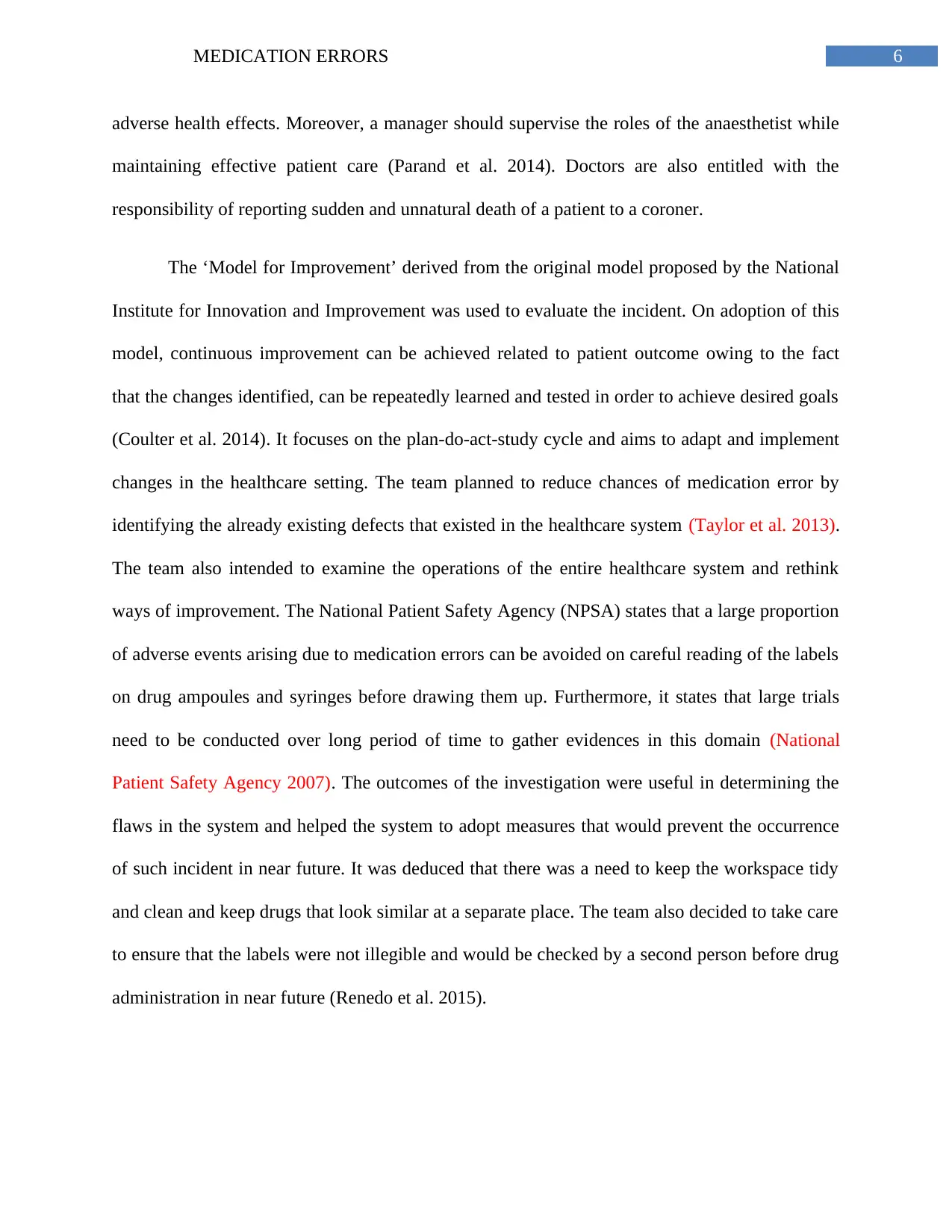
MEDICATION ERRORS 6
adverse health effects. Moreover, a manager should supervise the roles of the anaesthetist while
maintaining effective patient care (Parand et al. 2014). Doctors are also entitled with the
responsibility of reporting sudden and unnatural death of a patient to a coroner.
The ‘Model for Improvement’ derived from the original model proposed by the National
Institute for Innovation and Improvement was used to evaluate the incident. On adoption of this
model, continuous improvement can be achieved related to patient outcome owing to the fact
that the changes identified, can be repeatedly learned and tested in order to achieve desired goals
(Coulter et al. 2014). It focuses on the plan-do-act-study cycle and aims to adapt and implement
changes in the healthcare setting. The team planned to reduce chances of medication error by
identifying the already existing defects that existed in the healthcare system (Taylor et al. 2013).
The team also intended to examine the operations of the entire healthcare system and rethink
ways of improvement. The National Patient Safety Agency (NPSA) states that a large proportion
of adverse events arising due to medication errors can be avoided on careful reading of the labels
on drug ampoules and syringes before drawing them up. Furthermore, it states that large trials
need to be conducted over long period of time to gather evidences in this domain (National
Patient Safety Agency 2007). The outcomes of the investigation were useful in determining the
flaws in the system and helped the system to adopt measures that would prevent the occurrence
of such incident in near future. It was deduced that there was a need to keep the workspace tidy
and clean and keep drugs that look similar at a separate place. The team also decided to take care
to ensure that the labels were not illegible and would be checked by a second person before drug
administration in near future (Renedo et al. 2015).
adverse health effects. Moreover, a manager should supervise the roles of the anaesthetist while
maintaining effective patient care (Parand et al. 2014). Doctors are also entitled with the
responsibility of reporting sudden and unnatural death of a patient to a coroner.
The ‘Model for Improvement’ derived from the original model proposed by the National
Institute for Innovation and Improvement was used to evaluate the incident. On adoption of this
model, continuous improvement can be achieved related to patient outcome owing to the fact
that the changes identified, can be repeatedly learned and tested in order to achieve desired goals
(Coulter et al. 2014). It focuses on the plan-do-act-study cycle and aims to adapt and implement
changes in the healthcare setting. The team planned to reduce chances of medication error by
identifying the already existing defects that existed in the healthcare system (Taylor et al. 2013).
The team also intended to examine the operations of the entire healthcare system and rethink
ways of improvement. The National Patient Safety Agency (NPSA) states that a large proportion
of adverse events arising due to medication errors can be avoided on careful reading of the labels
on drug ampoules and syringes before drawing them up. Furthermore, it states that large trials
need to be conducted over long period of time to gather evidences in this domain (National
Patient Safety Agency 2007). The outcomes of the investigation were useful in determining the
flaws in the system and helped the system to adopt measures that would prevent the occurrence
of such incident in near future. It was deduced that there was a need to keep the workspace tidy
and clean and keep drugs that look similar at a separate place. The team also decided to take care
to ensure that the labels were not illegible and would be checked by a second person before drug
administration in near future (Renedo et al. 2015).
Paraphrase This Document
Need a fresh take? Get an instant paraphrase of this document with our AI Paraphraser
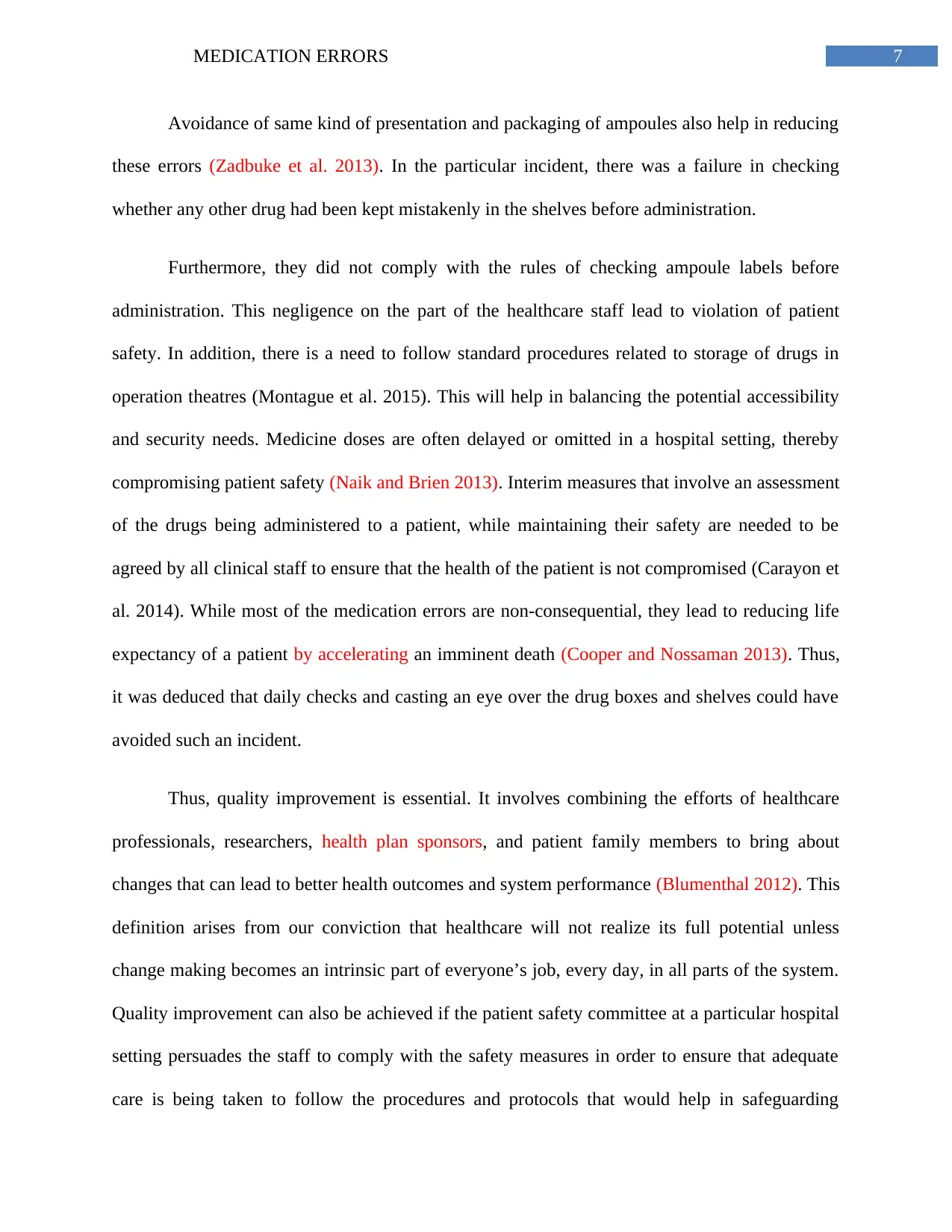
MEDICATION ERRORS 7
Avoidance of same kind of presentation and packaging of ampoules also help in reducing
these errors (Zadbuke et al. 2013). In the particular incident, there was a failure in checking
whether any other drug had been kept mistakenly in the shelves before administration.
Furthermore, they did not comply with the rules of checking ampoule labels before
administration. This negligence on the part of the healthcare staff lead to violation of patient
safety. In addition, there is a need to follow standard procedures related to storage of drugs in
operation theatres (Montague et al. 2015). This will help in balancing the potential accessibility
and security needs. Medicine doses are often delayed or omitted in a hospital setting, thereby
compromising patient safety (Naik and Brien 2013). Interim measures that involve an assessment
of the drugs being administered to a patient, while maintaining their safety are needed to be
agreed by all clinical staff to ensure that the health of the patient is not compromised (Carayon et
al. 2014). While most of the medication errors are non-consequential, they lead to reducing life
expectancy of a patient by accelerating an imminent death (Cooper and Nossaman 2013). Thus,
it was deduced that daily checks and casting an eye over the drug boxes and shelves could have
avoided such an incident.
Thus, quality improvement is essential. It involves combining the efforts of healthcare
professionals, researchers, health plan sponsors, and patient family members to bring about
changes that can lead to better health outcomes and system performance (Blumenthal 2012). This
definition arises from our conviction that healthcare will not realize its full potential unless
change making becomes an intrinsic part of everyone’s job, every day, in all parts of the system.
Quality improvement can also be achieved if the patient safety committee at a particular hospital
setting persuades the staff to comply with the safety measures in order to ensure that adequate
care is being taken to follow the procedures and protocols that would help in safeguarding
Avoidance of same kind of presentation and packaging of ampoules also help in reducing
these errors (Zadbuke et al. 2013). In the particular incident, there was a failure in checking
whether any other drug had been kept mistakenly in the shelves before administration.
Furthermore, they did not comply with the rules of checking ampoule labels before
administration. This negligence on the part of the healthcare staff lead to violation of patient
safety. In addition, there is a need to follow standard procedures related to storage of drugs in
operation theatres (Montague et al. 2015). This will help in balancing the potential accessibility
and security needs. Medicine doses are often delayed or omitted in a hospital setting, thereby
compromising patient safety (Naik and Brien 2013). Interim measures that involve an assessment
of the drugs being administered to a patient, while maintaining their safety are needed to be
agreed by all clinical staff to ensure that the health of the patient is not compromised (Carayon et
al. 2014). While most of the medication errors are non-consequential, they lead to reducing life
expectancy of a patient by accelerating an imminent death (Cooper and Nossaman 2013). Thus,
it was deduced that daily checks and casting an eye over the drug boxes and shelves could have
avoided such an incident.
Thus, quality improvement is essential. It involves combining the efforts of healthcare
professionals, researchers, health plan sponsors, and patient family members to bring about
changes that can lead to better health outcomes and system performance (Blumenthal 2012). This
definition arises from our conviction that healthcare will not realize its full potential unless
change making becomes an intrinsic part of everyone’s job, every day, in all parts of the system.
Quality improvement can also be achieved if the patient safety committee at a particular hospital
setting persuades the staff to comply with the safety measures in order to ensure that adequate
care is being taken to follow the procedures and protocols that would help in safeguarding
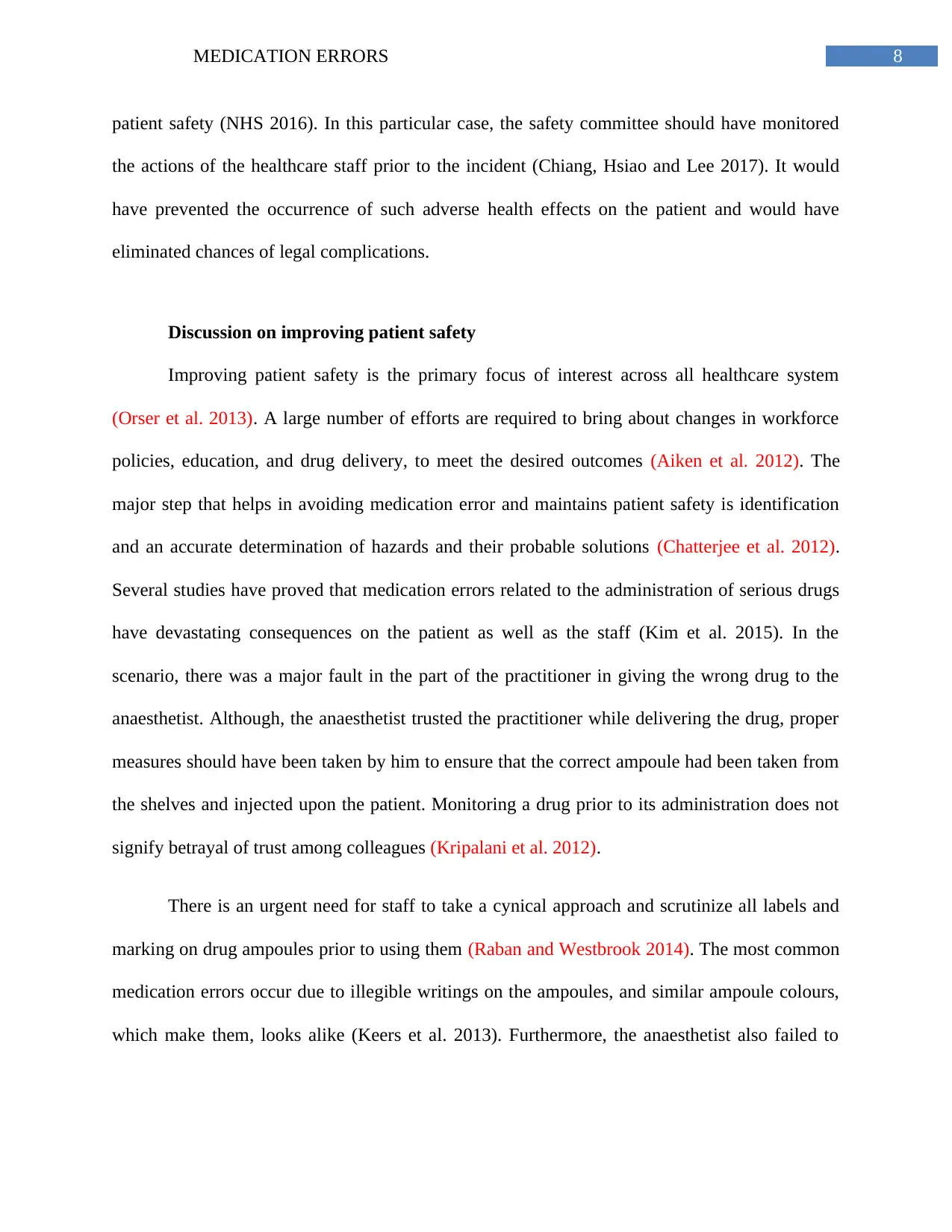
MEDICATION ERRORS 8
patient safety (NHS 2016). In this particular case, the safety committee should have monitored
the actions of the healthcare staff prior to the incident (Chiang, Hsiao and Lee 2017). It would
have prevented the occurrence of such adverse health effects on the patient and would have
eliminated chances of legal complications.
Discussion on improving patient safety
Improving patient safety is the primary focus of interest across all healthcare system
(Orser et al. 2013). A large number of efforts are required to bring about changes in workforce
policies, education, and drug delivery, to meet the desired outcomes (Aiken et al. 2012). The
major step that helps in avoiding medication error and maintains patient safety is identification
and an accurate determination of hazards and their probable solutions (Chatterjee et al. 2012).
Several studies have proved that medication errors related to the administration of serious drugs
have devastating consequences on the patient as well as the staff (Kim et al. 2015). In the
scenario, there was a major fault in the part of the practitioner in giving the wrong drug to the
anaesthetist. Although, the anaesthetist trusted the practitioner while delivering the drug, proper
measures should have been taken by him to ensure that the correct ampoule had been taken from
the shelves and injected upon the patient. Monitoring a drug prior to its administration does not
signify betrayal of trust among colleagues (Kripalani et al. 2012).
There is an urgent need for staff to take a cynical approach and scrutinize all labels and
marking on drug ampoules prior to using them (Raban and Westbrook 2014). The most common
medication errors occur due to illegible writings on the ampoules, and similar ampoule colours,
which make them, looks alike (Keers et al. 2013). Furthermore, the anaesthetist also failed to
patient safety (NHS 2016). In this particular case, the safety committee should have monitored
the actions of the healthcare staff prior to the incident (Chiang, Hsiao and Lee 2017). It would
have prevented the occurrence of such adverse health effects on the patient and would have
eliminated chances of legal complications.
Discussion on improving patient safety
Improving patient safety is the primary focus of interest across all healthcare system
(Orser et al. 2013). A large number of efforts are required to bring about changes in workforce
policies, education, and drug delivery, to meet the desired outcomes (Aiken et al. 2012). The
major step that helps in avoiding medication error and maintains patient safety is identification
and an accurate determination of hazards and their probable solutions (Chatterjee et al. 2012).
Several studies have proved that medication errors related to the administration of serious drugs
have devastating consequences on the patient as well as the staff (Kim et al. 2015). In the
scenario, there was a major fault in the part of the practitioner in giving the wrong drug to the
anaesthetist. Although, the anaesthetist trusted the practitioner while delivering the drug, proper
measures should have been taken by him to ensure that the correct ampoule had been taken from
the shelves and injected upon the patient. Monitoring a drug prior to its administration does not
signify betrayal of trust among colleagues (Kripalani et al. 2012).
There is an urgent need for staff to take a cynical approach and scrutinize all labels and
marking on drug ampoules prior to using them (Raban and Westbrook 2014). The most common
medication errors occur due to illegible writings on the ampoules, and similar ampoule colours,
which make them, looks alike (Keers et al. 2013). Furthermore, the anaesthetist also failed to
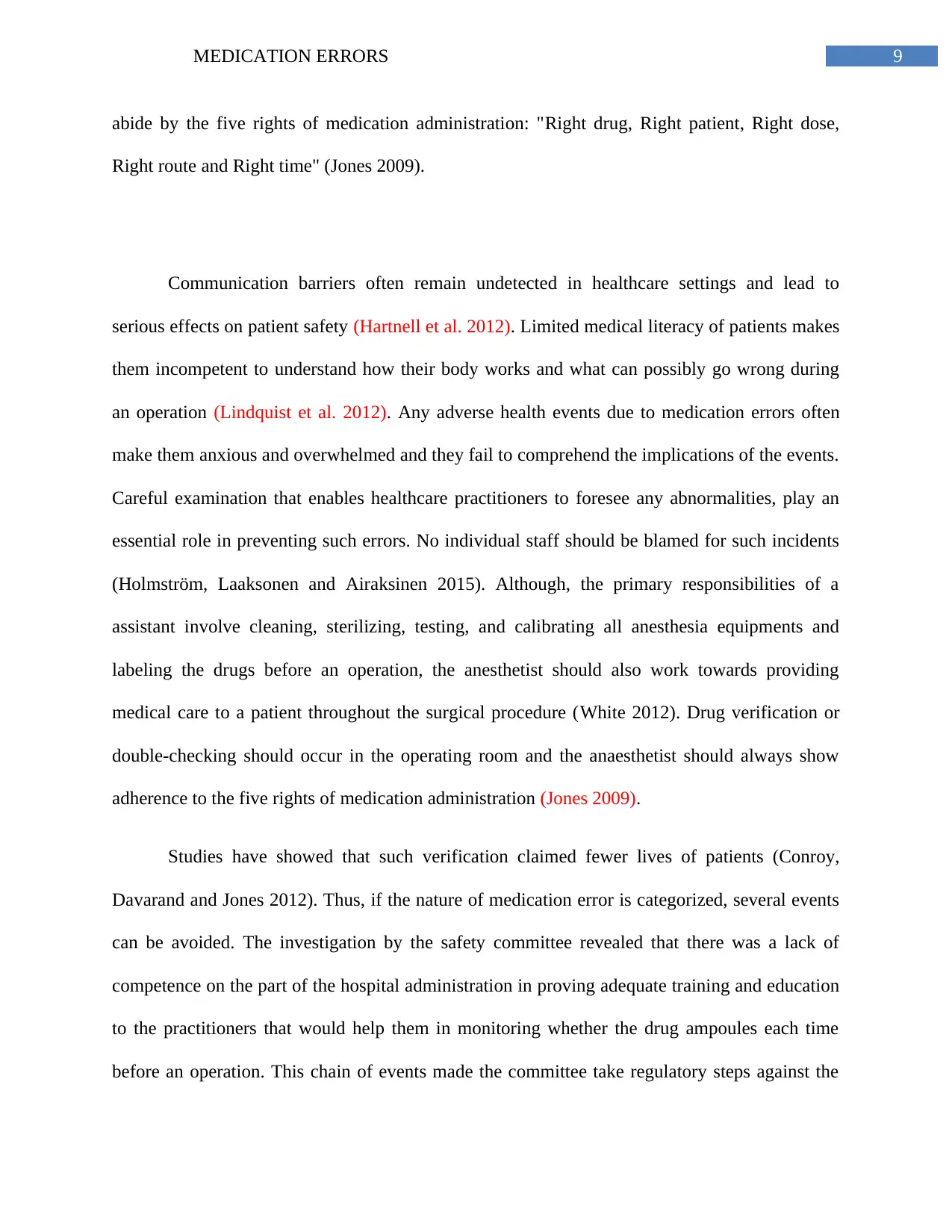
MEDICATION ERRORS 9
abide by the five rights of medication administration: "Right drug, Right patient, Right dose,
Right route and Right time" (Jones 2009).
Communication barriers often remain undetected in healthcare settings and lead to
serious effects on patient safety (Hartnell et al. 2012). Limited medical literacy of patients makes
them incompetent to understand how their body works and what can possibly go wrong during
an operation (Lindquist et al. 2012). Any adverse health events due to medication errors often
make them anxious and overwhelmed and they fail to comprehend the implications of the events.
Careful examination that enables healthcare practitioners to foresee any abnormalities, play an
essential role in preventing such errors. No individual staff should be blamed for such incidents
(Holmström, Laaksonen and Airaksinen 2015). Although, the primary responsibilities of a
assistant involve cleaning, sterilizing, testing, and calibrating all anesthesia equipments and
labeling the drugs before an operation, the anesthetist should also work towards providing
medical care to a patient throughout the surgical procedure (White 2012). Drug verification or
double-checking should occur in the operating room and the anaesthetist should always show
adherence to the five rights of medication administration (Jones 2009).
Studies have showed that such verification claimed fewer lives of patients (Conroy,
Davarand and Jones 2012). Thus, if the nature of medication error is categorized, several events
can be avoided. The investigation by the safety committee revealed that there was a lack of
competence on the part of the hospital administration in proving adequate training and education
to the practitioners that would help them in monitoring whether the drug ampoules each time
before an operation. This chain of events made the committee take regulatory steps against the
abide by the five rights of medication administration: "Right drug, Right patient, Right dose,
Right route and Right time" (Jones 2009).
Communication barriers often remain undetected in healthcare settings and lead to
serious effects on patient safety (Hartnell et al. 2012). Limited medical literacy of patients makes
them incompetent to understand how their body works and what can possibly go wrong during
an operation (Lindquist et al. 2012). Any adverse health events due to medication errors often
make them anxious and overwhelmed and they fail to comprehend the implications of the events.
Careful examination that enables healthcare practitioners to foresee any abnormalities, play an
essential role in preventing such errors. No individual staff should be blamed for such incidents
(Holmström, Laaksonen and Airaksinen 2015). Although, the primary responsibilities of a
assistant involve cleaning, sterilizing, testing, and calibrating all anesthesia equipments and
labeling the drugs before an operation, the anesthetist should also work towards providing
medical care to a patient throughout the surgical procedure (White 2012). Drug verification or
double-checking should occur in the operating room and the anaesthetist should always show
adherence to the five rights of medication administration (Jones 2009).
Studies have showed that such verification claimed fewer lives of patients (Conroy,
Davarand and Jones 2012). Thus, if the nature of medication error is categorized, several events
can be avoided. The investigation by the safety committee revealed that there was a lack of
competence on the part of the hospital administration in proving adequate training and education
to the practitioners that would help them in monitoring whether the drug ampoules each time
before an operation. This chain of events made the committee take regulatory steps against the
Secure Best Marks with AI Grader
Need help grading? Try our AI Grader for instant feedback on your assignments.
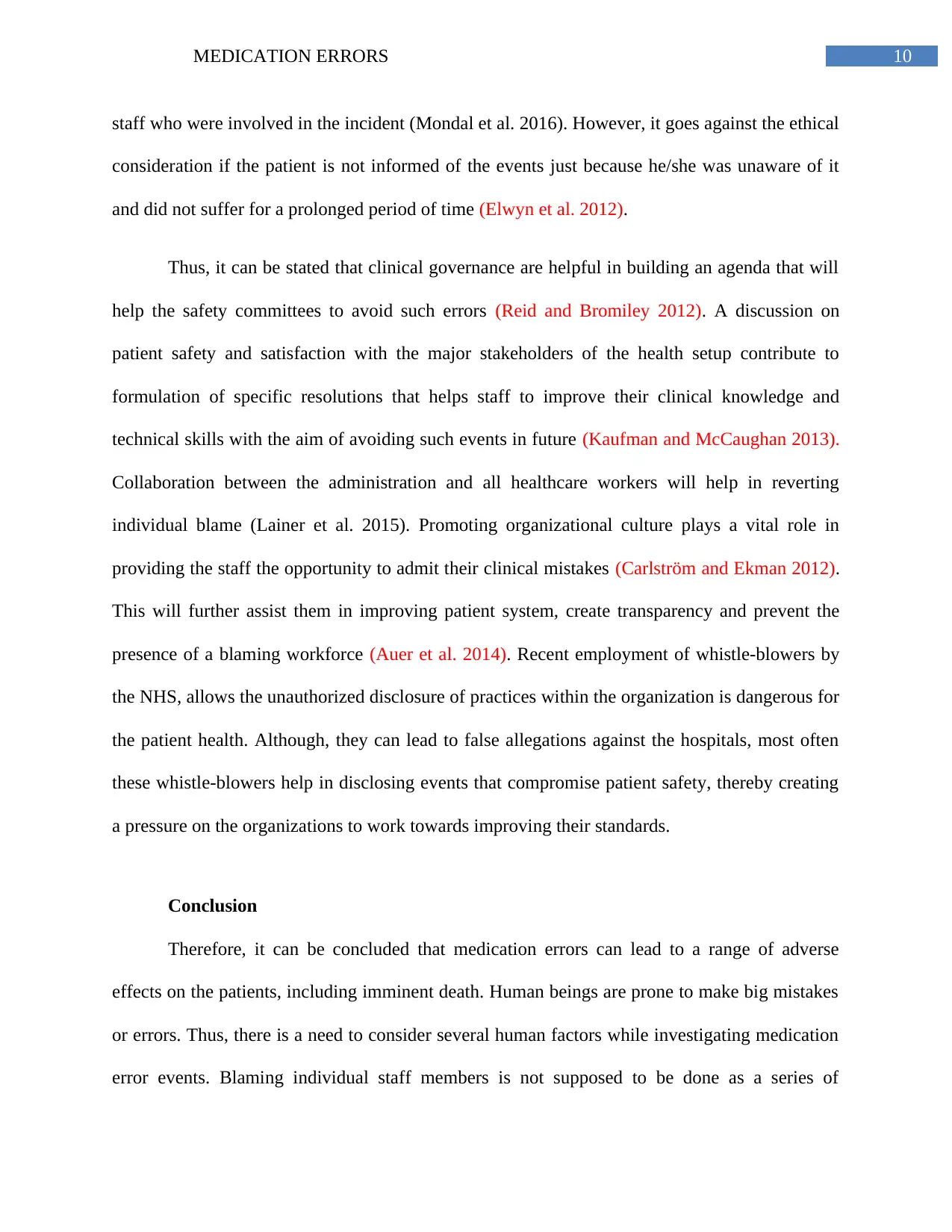
MEDICATION ERRORS 10
staff who were involved in the incident (Mondal et al. 2016). However, it goes against the ethical
consideration if the patient is not informed of the events just because he/she was unaware of it
and did not suffer for a prolonged period of time (Elwyn et al. 2012).
Thus, it can be stated that clinical governance are helpful in building an agenda that will
help the safety committees to avoid such errors (Reid and Bromiley 2012). A discussion on
patient safety and satisfaction with the major stakeholders of the health setup contribute to
formulation of specific resolutions that helps staff to improve their clinical knowledge and
technical skills with the aim of avoiding such events in future (Kaufman and McCaughan 2013).
Collaboration between the administration and all healthcare workers will help in reverting
individual blame (Lainer et al. 2015). Promoting organizational culture plays a vital role in
providing the staff the opportunity to admit their clinical mistakes (Carlström and Ekman 2012).
This will further assist them in improving patient system, create transparency and prevent the
presence of a blaming workforce (Auer et al. 2014). Recent employment of whistle-blowers by
the NHS, allows the unauthorized disclosure of practices within the organization is dangerous for
the patient health. Although, they can lead to false allegations against the hospitals, most often
these whistle-blowers help in disclosing events that compromise patient safety, thereby creating
a pressure on the organizations to work towards improving their standards.
Conclusion
Therefore, it can be concluded that medication errors can lead to a range of adverse
effects on the patients, including imminent death. Human beings are prone to make big mistakes
or errors. Thus, there is a need to consider several human factors while investigating medication
error events. Blaming individual staff members is not supposed to be done as a series of
staff who were involved in the incident (Mondal et al. 2016). However, it goes against the ethical
consideration if the patient is not informed of the events just because he/she was unaware of it
and did not suffer for a prolonged period of time (Elwyn et al. 2012).
Thus, it can be stated that clinical governance are helpful in building an agenda that will
help the safety committees to avoid such errors (Reid and Bromiley 2012). A discussion on
patient safety and satisfaction with the major stakeholders of the health setup contribute to
formulation of specific resolutions that helps staff to improve their clinical knowledge and
technical skills with the aim of avoiding such events in future (Kaufman and McCaughan 2013).
Collaboration between the administration and all healthcare workers will help in reverting
individual blame (Lainer et al. 2015). Promoting organizational culture plays a vital role in
providing the staff the opportunity to admit their clinical mistakes (Carlström and Ekman 2012).
This will further assist them in improving patient system, create transparency and prevent the
presence of a blaming workforce (Auer et al. 2014). Recent employment of whistle-blowers by
the NHS, allows the unauthorized disclosure of practices within the organization is dangerous for
the patient health. Although, they can lead to false allegations against the hospitals, most often
these whistle-blowers help in disclosing events that compromise patient safety, thereby creating
a pressure on the organizations to work towards improving their standards.
Conclusion
Therefore, it can be concluded that medication errors can lead to a range of adverse
effects on the patients, including imminent death. Human beings are prone to make big mistakes
or errors. Thus, there is a need to consider several human factors while investigating medication
error events. Blaming individual staff members is not supposed to be done as a series of
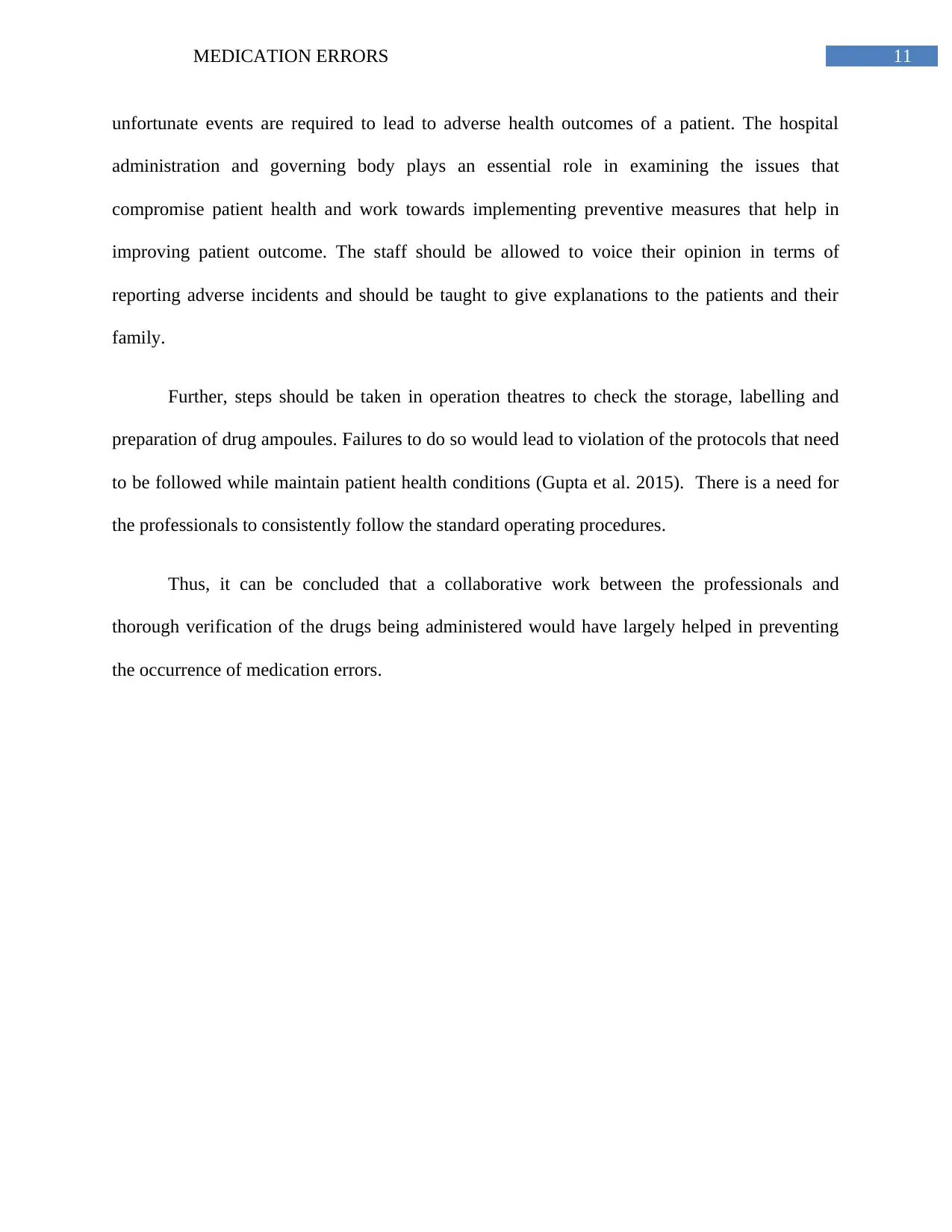
MEDICATION ERRORS 11
unfortunate events are required to lead to adverse health outcomes of a patient. The hospital
administration and governing body plays an essential role in examining the issues that
compromise patient health and work towards implementing preventive measures that help in
improving patient outcome. The staff should be allowed to voice their opinion in terms of
reporting adverse incidents and should be taught to give explanations to the patients and their
family.
Further, steps should be taken in operation theatres to check the storage, labelling and
preparation of drug ampoules. Failures to do so would lead to violation of the protocols that need
to be followed while maintain patient health conditions (Gupta et al. 2015). There is a need for
the professionals to consistently follow the standard operating procedures.
Thus, it can be concluded that a collaborative work between the professionals and
thorough verification of the drugs being administered would have largely helped in preventing
the occurrence of medication errors.
unfortunate events are required to lead to adverse health outcomes of a patient. The hospital
administration and governing body plays an essential role in examining the issues that
compromise patient health and work towards implementing preventive measures that help in
improving patient outcome. The staff should be allowed to voice their opinion in terms of
reporting adverse incidents and should be taught to give explanations to the patients and their
family.
Further, steps should be taken in operation theatres to check the storage, labelling and
preparation of drug ampoules. Failures to do so would lead to violation of the protocols that need
to be followed while maintain patient health conditions (Gupta et al. 2015). There is a need for
the professionals to consistently follow the standard operating procedures.
Thus, it can be concluded that a collaborative work between the professionals and
thorough verification of the drugs being administered would have largely helped in preventing
the occurrence of medication errors.
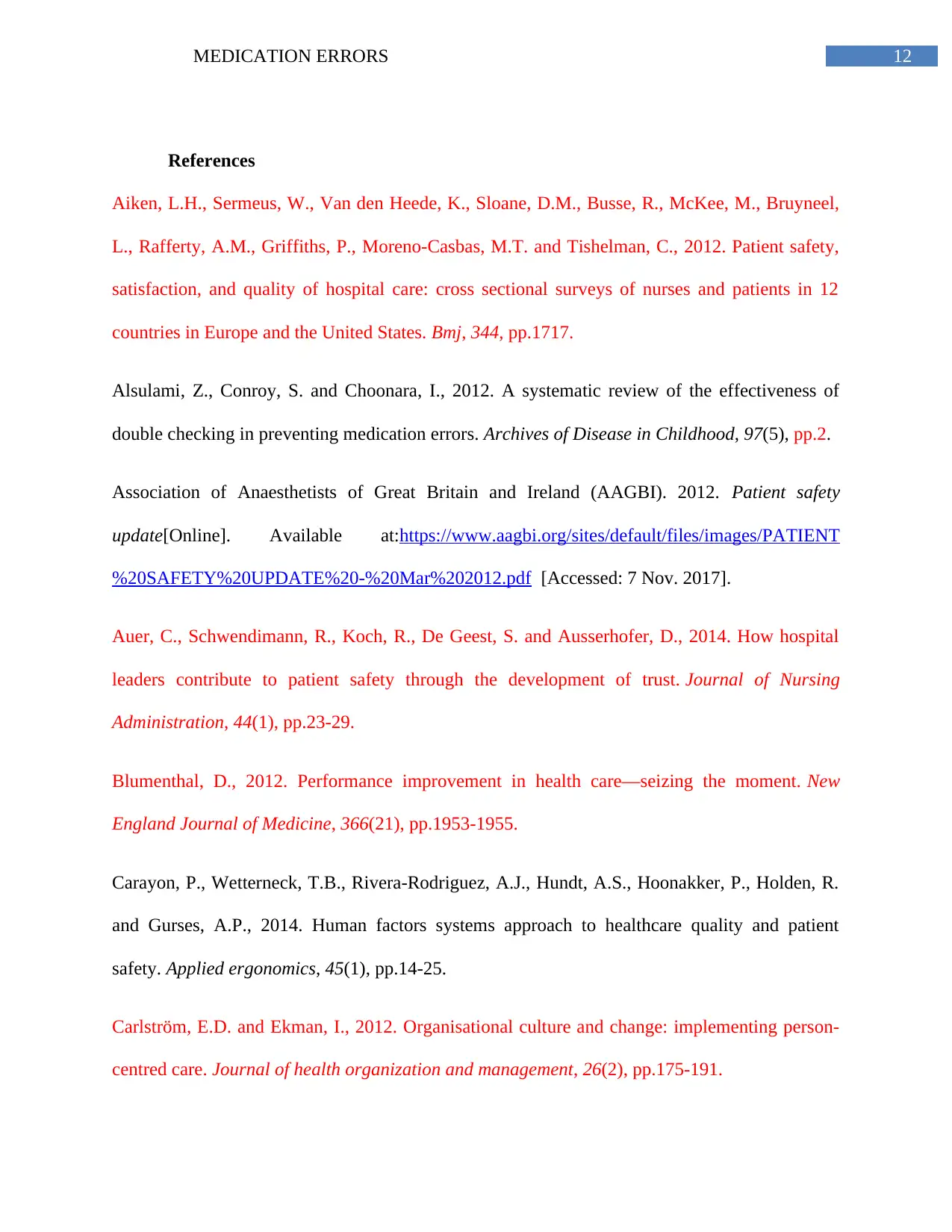
MEDICATION ERRORS 12
References
Aiken, L.H., Sermeus, W., Van den Heede, K., Sloane, D.M., Busse, R., McKee, M., Bruyneel,
L., Rafferty, A.M., Griffiths, P., Moreno-Casbas, M.T. and Tishelman, C., 2012. Patient safety,
satisfaction, and quality of hospital care: cross sectional surveys of nurses and patients in 12
countries in Europe and the United States. Bmj, 344, pp.1717.
Alsulami, Z., Conroy, S. and Choonara, I., 2012. A systematic review of the effectiveness of
double checking in preventing medication errors. Archives of Disease in Childhood, 97(5), pp.2.
Association of Anaesthetists of Great Britain and Ireland (AAGBI). 2012. Patient safety
update[Online]. Available at:https://www.aagbi.org/sites/default/files/images/PATIENT
%20SAFETY%20UPDATE%20-%20Mar%202012.pdf [Accessed: 7 Nov. 2017].
Auer, C., Schwendimann, R., Koch, R., De Geest, S. and Ausserhofer, D., 2014. How hospital
leaders contribute to patient safety through the development of trust. Journal of Nursing
Administration, 44(1), pp.23-29.
Blumenthal, D., 2012. Performance improvement in health care—seizing the moment. New
England Journal of Medicine, 366(21), pp.1953-1955.
Carayon, P., Wetterneck, T.B., Rivera-Rodriguez, A.J., Hundt, A.S., Hoonakker, P., Holden, R.
and Gurses, A.P., 2014. Human factors systems approach to healthcare quality and patient
safety. Applied ergonomics, 45(1), pp.14-25.
Carlström, E.D. and Ekman, I., 2012. Organisational culture and change: implementing person-
centred care. Journal of health organization and management, 26(2), pp.175-191.
References
Aiken, L.H., Sermeus, W., Van den Heede, K., Sloane, D.M., Busse, R., McKee, M., Bruyneel,
L., Rafferty, A.M., Griffiths, P., Moreno-Casbas, M.T. and Tishelman, C., 2012. Patient safety,
satisfaction, and quality of hospital care: cross sectional surveys of nurses and patients in 12
countries in Europe and the United States. Bmj, 344, pp.1717.
Alsulami, Z., Conroy, S. and Choonara, I., 2012. A systematic review of the effectiveness of
double checking in preventing medication errors. Archives of Disease in Childhood, 97(5), pp.2.
Association of Anaesthetists of Great Britain and Ireland (AAGBI). 2012. Patient safety
update[Online]. Available at:https://www.aagbi.org/sites/default/files/images/PATIENT
%20SAFETY%20UPDATE%20-%20Mar%202012.pdf [Accessed: 7 Nov. 2017].
Auer, C., Schwendimann, R., Koch, R., De Geest, S. and Ausserhofer, D., 2014. How hospital
leaders contribute to patient safety through the development of trust. Journal of Nursing
Administration, 44(1), pp.23-29.
Blumenthal, D., 2012. Performance improvement in health care—seizing the moment. New
England Journal of Medicine, 366(21), pp.1953-1955.
Carayon, P., Wetterneck, T.B., Rivera-Rodriguez, A.J., Hundt, A.S., Hoonakker, P., Holden, R.
and Gurses, A.P., 2014. Human factors systems approach to healthcare quality and patient
safety. Applied ergonomics, 45(1), pp.14-25.
Carlström, E.D. and Ekman, I., 2012. Organisational culture and change: implementing person-
centred care. Journal of health organization and management, 26(2), pp.175-191.
Paraphrase This Document
Need a fresh take? Get an instant paraphrase of this document with our AI Paraphraser
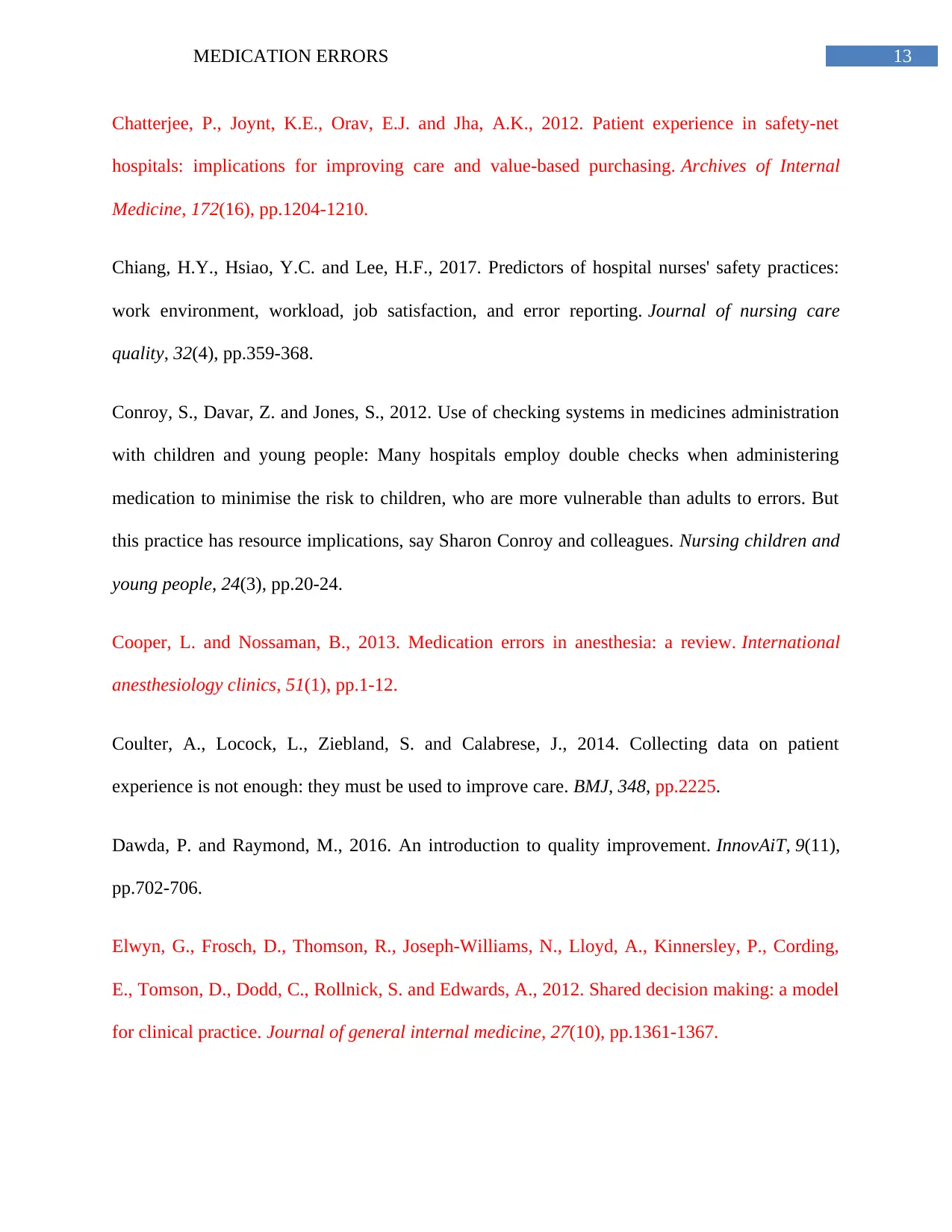
MEDICATION ERRORS 13
Chatterjee, P., Joynt, K.E., Orav, E.J. and Jha, A.K., 2012. Patient experience in safety-net
hospitals: implications for improving care and value-based purchasing. Archives of Internal
Medicine, 172(16), pp.1204-1210.
Chiang, H.Y., Hsiao, Y.C. and Lee, H.F., 2017. Predictors of hospital nurses' safety practices:
work environment, workload, job satisfaction, and error reporting. Journal of nursing care
quality, 32(4), pp.359-368.
Conroy, S., Davar, Z. and Jones, S., 2012. Use of checking systems in medicines administration
with children and young people: Many hospitals employ double checks when administering
medication to minimise the risk to children, who are more vulnerable than adults to errors. But
this practice has resource implications, say Sharon Conroy and colleagues. Nursing children and
young people, 24(3), pp.20-24.
Cooper, L. and Nossaman, B., 2013. Medication errors in anesthesia: a review. International
anesthesiology clinics, 51(1), pp.1-12.
Coulter, A., Locock, L., Ziebland, S. and Calabrese, J., 2014. Collecting data on patient
experience is not enough: they must be used to improve care. BMJ, 348, pp.2225.
Dawda, P. and Raymond, M., 2016. An introduction to quality improvement. InnovAiT, 9(11),
pp.702-706.
Elwyn, G., Frosch, D., Thomson, R., Joseph-Williams, N., Lloyd, A., Kinnersley, P., Cording,
E., Tomson, D., Dodd, C., Rollnick, S. and Edwards, A., 2012. Shared decision making: a model
for clinical practice. Journal of general internal medicine, 27(10), pp.1361-1367.
Chatterjee, P., Joynt, K.E., Orav, E.J. and Jha, A.K., 2012. Patient experience in safety-net
hospitals: implications for improving care and value-based purchasing. Archives of Internal
Medicine, 172(16), pp.1204-1210.
Chiang, H.Y., Hsiao, Y.C. and Lee, H.F., 2017. Predictors of hospital nurses' safety practices:
work environment, workload, job satisfaction, and error reporting. Journal of nursing care
quality, 32(4), pp.359-368.
Conroy, S., Davar, Z. and Jones, S., 2012. Use of checking systems in medicines administration
with children and young people: Many hospitals employ double checks when administering
medication to minimise the risk to children, who are more vulnerable than adults to errors. But
this practice has resource implications, say Sharon Conroy and colleagues. Nursing children and
young people, 24(3), pp.20-24.
Cooper, L. and Nossaman, B., 2013. Medication errors in anesthesia: a review. International
anesthesiology clinics, 51(1), pp.1-12.
Coulter, A., Locock, L., Ziebland, S. and Calabrese, J., 2014. Collecting data on patient
experience is not enough: they must be used to improve care. BMJ, 348, pp.2225.
Dawda, P. and Raymond, M., 2016. An introduction to quality improvement. InnovAiT, 9(11),
pp.702-706.
Elwyn, G., Frosch, D., Thomson, R., Joseph-Williams, N., Lloyd, A., Kinnersley, P., Cording,
E., Tomson, D., Dodd, C., Rollnick, S. and Edwards, A., 2012. Shared decision making: a model
for clinical practice. Journal of general internal medicine, 27(10), pp.1361-1367.
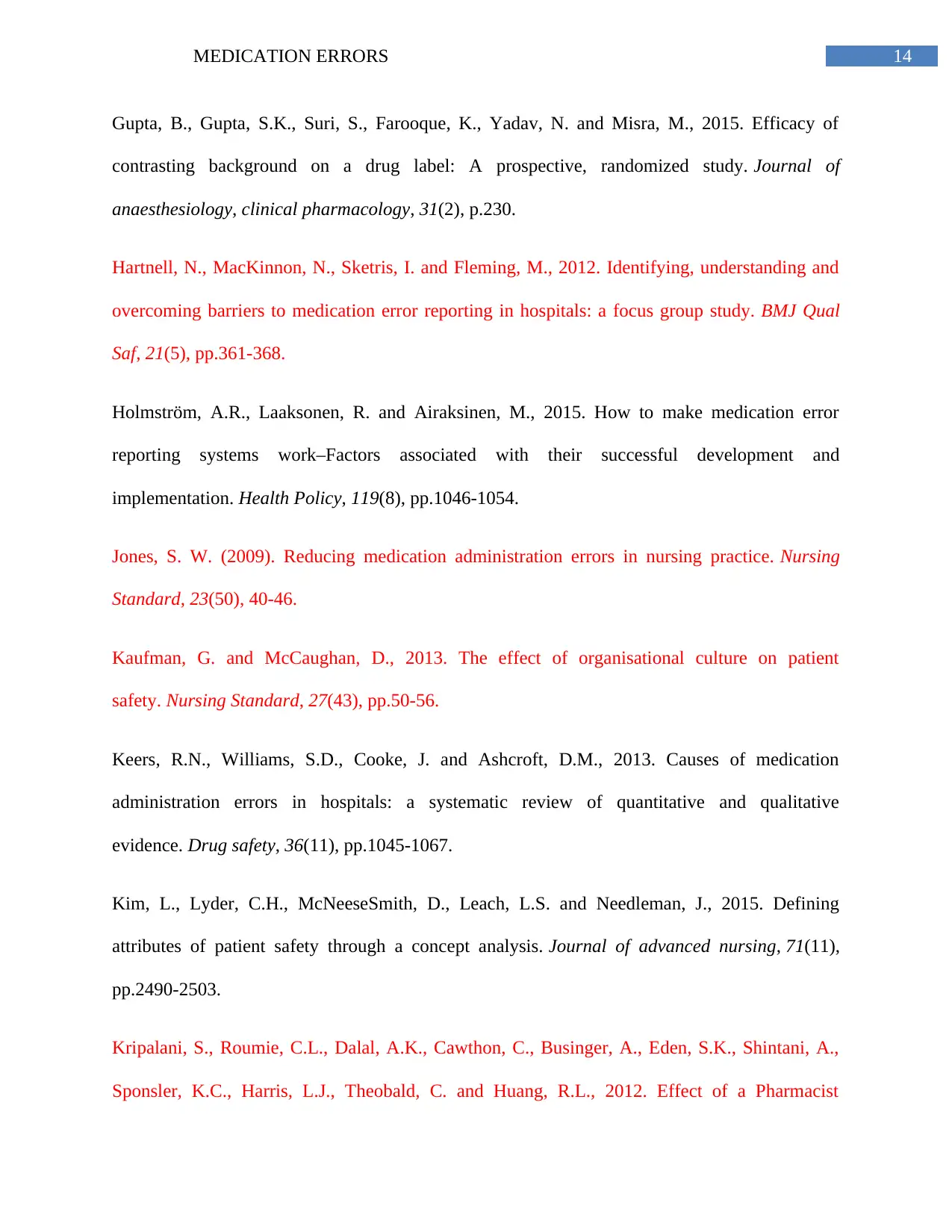
MEDICATION ERRORS 14
Gupta, B., Gupta, S.K., Suri, S., Farooque, K., Yadav, N. and Misra, M., 2015. Efficacy of
contrasting background on a drug label: A prospective, randomized study. Journal of
anaesthesiology, clinical pharmacology, 31(2), p.230.
Hartnell, N., MacKinnon, N., Sketris, I. and Fleming, M., 2012. Identifying, understanding and
overcoming barriers to medication error reporting in hospitals: a focus group study. BMJ Qual
Saf, 21(5), pp.361-368.
Holmström, A.R., Laaksonen, R. and Airaksinen, M., 2015. How to make medication error
reporting systems work–Factors associated with their successful development and
implementation. Health Policy, 119(8), pp.1046-1054.
Jones, S. W. (2009). Reducing medication administration errors in nursing practice. Nursing
Standard, 23(50), 40-46.
Kaufman, G. and McCaughan, D., 2013. The effect of organisational culture on patient
safety. Nursing Standard, 27(43), pp.50-56.
Keers, R.N., Williams, S.D., Cooke, J. and Ashcroft, D.M., 2013. Causes of medication
administration errors in hospitals: a systematic review of quantitative and qualitative
evidence. Drug safety, 36(11), pp.1045-1067.
Kim, L., Lyder, C.H., McNeeseSmith, D., Leach, L.S. and Needleman, J., 2015. Defining
attributes of patient safety through a concept analysis. Journal of advanced nursing, 71(11),
pp.2490-2503.
Kripalani, S., Roumie, C.L., Dalal, A.K., Cawthon, C., Businger, A., Eden, S.K., Shintani, A.,
Sponsler, K.C., Harris, L.J., Theobald, C. and Huang, R.L., 2012. Effect of a Pharmacist
Gupta, B., Gupta, S.K., Suri, S., Farooque, K., Yadav, N. and Misra, M., 2015. Efficacy of
contrasting background on a drug label: A prospective, randomized study. Journal of
anaesthesiology, clinical pharmacology, 31(2), p.230.
Hartnell, N., MacKinnon, N., Sketris, I. and Fleming, M., 2012. Identifying, understanding and
overcoming barriers to medication error reporting in hospitals: a focus group study. BMJ Qual
Saf, 21(5), pp.361-368.
Holmström, A.R., Laaksonen, R. and Airaksinen, M., 2015. How to make medication error
reporting systems work–Factors associated with their successful development and
implementation. Health Policy, 119(8), pp.1046-1054.
Jones, S. W. (2009). Reducing medication administration errors in nursing practice. Nursing
Standard, 23(50), 40-46.
Kaufman, G. and McCaughan, D., 2013. The effect of organisational culture on patient
safety. Nursing Standard, 27(43), pp.50-56.
Keers, R.N., Williams, S.D., Cooke, J. and Ashcroft, D.M., 2013. Causes of medication
administration errors in hospitals: a systematic review of quantitative and qualitative
evidence. Drug safety, 36(11), pp.1045-1067.
Kim, L., Lyder, C.H., McNeeseSmith, D., Leach, L.S. and Needleman, J., 2015. Defining
attributes of patient safety through a concept analysis. Journal of advanced nursing, 71(11),
pp.2490-2503.
Kripalani, S., Roumie, C.L., Dalal, A.K., Cawthon, C., Businger, A., Eden, S.K., Shintani, A.,
Sponsler, K.C., Harris, L.J., Theobald, C. and Huang, R.L., 2012. Effect of a Pharmacist
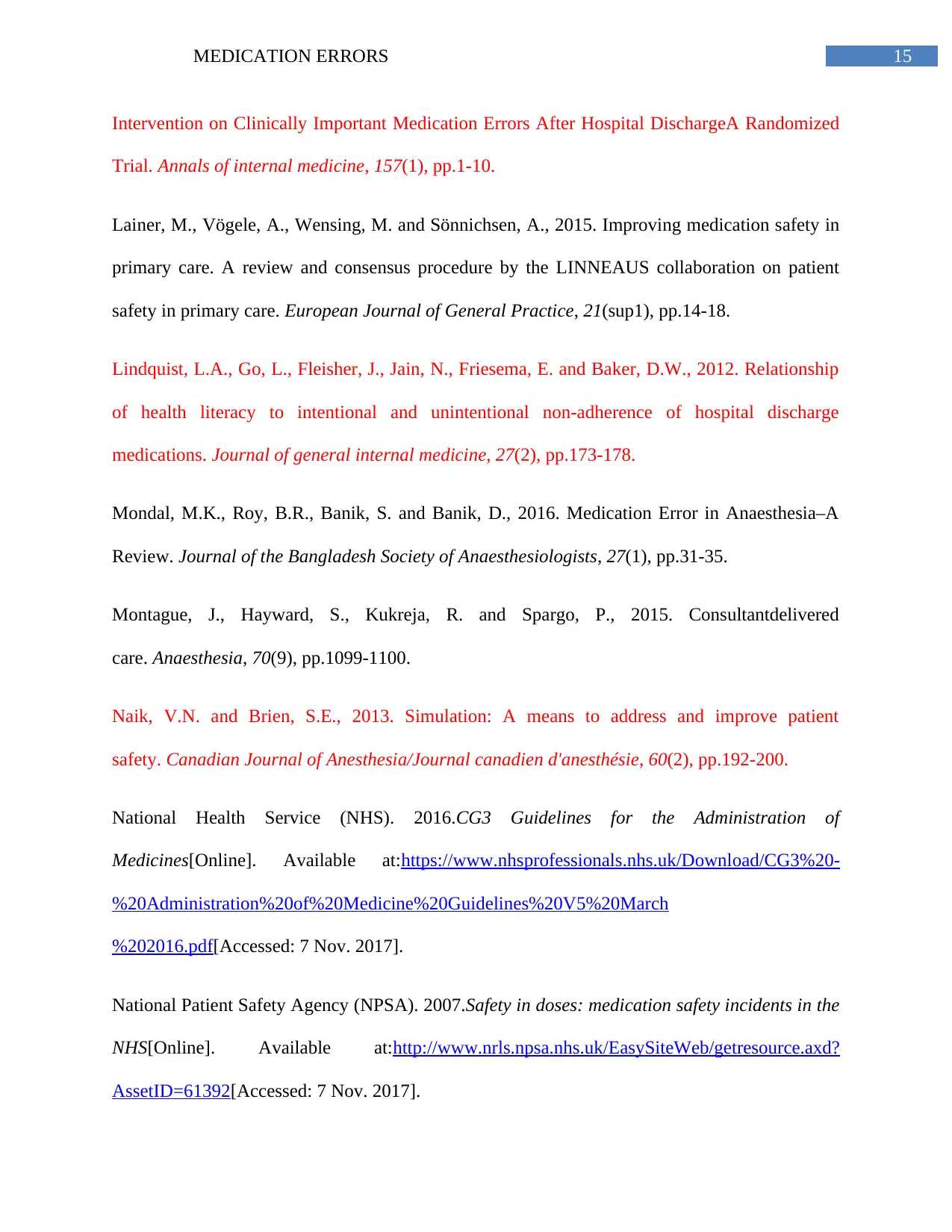
MEDICATION ERRORS 15
Intervention on Clinically Important Medication Errors After Hospital DischargeA Randomized
Trial. Annals of internal medicine, 157(1), pp.1-10.
Lainer, M., Vögele, A., Wensing, M. and Sönnichsen, A., 2015. Improving medication safety in
primary care. A review and consensus procedure by the LINNEAUS collaboration on patient
safety in primary care. European Journal of General Practice, 21(sup1), pp.14-18.
Lindquist, L.A., Go, L., Fleisher, J., Jain, N., Friesema, E. and Baker, D.W., 2012. Relationship
of health literacy to intentional and unintentional non-adherence of hospital discharge
medications. Journal of general internal medicine, 27(2), pp.173-178.
Mondal, M.K., Roy, B.R., Banik, S. and Banik, D., 2016. Medication Error in Anaesthesia–A
Review. Journal of the Bangladesh Society of Anaesthesiologists, 27(1), pp.31-35.
Montague, J., Hayward, S., Kukreja, R. and Spargo, P., 2015. Consultantdelivered
care. Anaesthesia, 70(9), pp.1099-1100.
Naik, V.N. and Brien, S.E., 2013. Simulation: A means to address and improve patient
safety. Canadian Journal of Anesthesia/Journal canadien d'anesthésie, 60(2), pp.192-200.
National Health Service (NHS). 2016.CG3 Guidelines for the Administration of
Medicines[Online]. Available at:https://www.nhsprofessionals.nhs.uk/Download/CG3%20-
%20Administration%20of%20Medicine%20Guidelines%20V5%20March
%202016.pdf[Accessed: 7 Nov. 2017].
National Patient Safety Agency (NPSA). 2007.Safety in doses: medication safety incidents in the
NHS[Online]. Available at:http://www.nrls.npsa.nhs.uk/EasySiteWeb/getresource.axd?
AssetID=61392[Accessed: 7 Nov. 2017].
Intervention on Clinically Important Medication Errors After Hospital DischargeA Randomized
Trial. Annals of internal medicine, 157(1), pp.1-10.
Lainer, M., Vögele, A., Wensing, M. and Sönnichsen, A., 2015. Improving medication safety in
primary care. A review and consensus procedure by the LINNEAUS collaboration on patient
safety in primary care. European Journal of General Practice, 21(sup1), pp.14-18.
Lindquist, L.A., Go, L., Fleisher, J., Jain, N., Friesema, E. and Baker, D.W., 2012. Relationship
of health literacy to intentional and unintentional non-adherence of hospital discharge
medications. Journal of general internal medicine, 27(2), pp.173-178.
Mondal, M.K., Roy, B.R., Banik, S. and Banik, D., 2016. Medication Error in Anaesthesia–A
Review. Journal of the Bangladesh Society of Anaesthesiologists, 27(1), pp.31-35.
Montague, J., Hayward, S., Kukreja, R. and Spargo, P., 2015. Consultantdelivered
care. Anaesthesia, 70(9), pp.1099-1100.
Naik, V.N. and Brien, S.E., 2013. Simulation: A means to address and improve patient
safety. Canadian Journal of Anesthesia/Journal canadien d'anesthésie, 60(2), pp.192-200.
National Health Service (NHS). 2016.CG3 Guidelines for the Administration of
Medicines[Online]. Available at:https://www.nhsprofessionals.nhs.uk/Download/CG3%20-
%20Administration%20of%20Medicine%20Guidelines%20V5%20March
%202016.pdf[Accessed: 7 Nov. 2017].
National Patient Safety Agency (NPSA). 2007.Safety in doses: medication safety incidents in the
NHS[Online]. Available at:http://www.nrls.npsa.nhs.uk/EasySiteWeb/getresource.axd?
AssetID=61392[Accessed: 7 Nov. 2017].
Secure Best Marks with AI Grader
Need help grading? Try our AI Grader for instant feedback on your assignments.
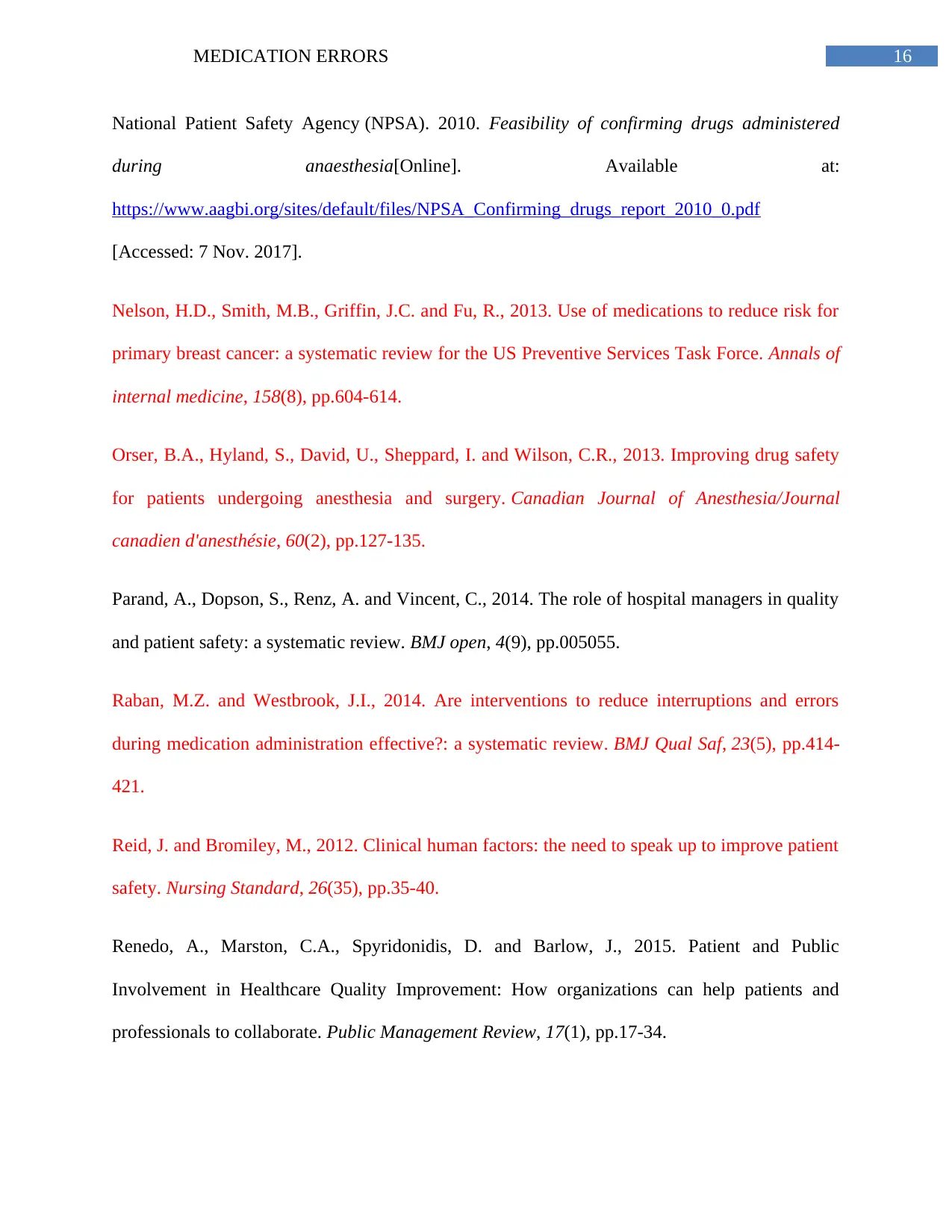
MEDICATION ERRORS 16
National Patient Safety Agency (NPSA). 2010. Feasibility of confirming drugs administered
during anaesthesia[Online]. Available at:
https://www.aagbi.org/sites/default/files/NPSA_Confirming_drugs_report_2010_0.pdf
[Accessed: 7 Nov. 2017].
Nelson, H.D., Smith, M.B., Griffin, J.C. and Fu, R., 2013. Use of medications to reduce risk for
primary breast cancer: a systematic review for the US Preventive Services Task Force. Annals of
internal medicine, 158(8), pp.604-614.
Orser, B.A., Hyland, S., David, U., Sheppard, I. and Wilson, C.R., 2013. Improving drug safety
for patients undergoing anesthesia and surgery. Canadian Journal of Anesthesia/Journal
canadien d'anesthésie, 60(2), pp.127-135.
Parand, A., Dopson, S., Renz, A. and Vincent, C., 2014. The role of hospital managers in quality
and patient safety: a systematic review. BMJ open, 4(9), pp.005055.
Raban, M.Z. and Westbrook, J.I., 2014. Are interventions to reduce interruptions and errors
during medication administration effective?: a systematic review. BMJ Qual Saf, 23(5), pp.414-
421.
Reid, J. and Bromiley, M., 2012. Clinical human factors: the need to speak up to improve patient
safety. Nursing Standard, 26(35), pp.35-40.
Renedo, A., Marston, C.A., Spyridonidis, D. and Barlow, J., 2015. Patient and Public
Involvement in Healthcare Quality Improvement: How organizations can help patients and
professionals to collaborate. Public Management Review, 17(1), pp.17-34.
National Patient Safety Agency (NPSA). 2010. Feasibility of confirming drugs administered
during anaesthesia[Online]. Available at:
https://www.aagbi.org/sites/default/files/NPSA_Confirming_drugs_report_2010_0.pdf
[Accessed: 7 Nov. 2017].
Nelson, H.D., Smith, M.B., Griffin, J.C. and Fu, R., 2013. Use of medications to reduce risk for
primary breast cancer: a systematic review for the US Preventive Services Task Force. Annals of
internal medicine, 158(8), pp.604-614.
Orser, B.A., Hyland, S., David, U., Sheppard, I. and Wilson, C.R., 2013. Improving drug safety
for patients undergoing anesthesia and surgery. Canadian Journal of Anesthesia/Journal
canadien d'anesthésie, 60(2), pp.127-135.
Parand, A., Dopson, S., Renz, A. and Vincent, C., 2014. The role of hospital managers in quality
and patient safety: a systematic review. BMJ open, 4(9), pp.005055.
Raban, M.Z. and Westbrook, J.I., 2014. Are interventions to reduce interruptions and errors
during medication administration effective?: a systematic review. BMJ Qual Saf, 23(5), pp.414-
421.
Reid, J. and Bromiley, M., 2012. Clinical human factors: the need to speak up to improve patient
safety. Nursing Standard, 26(35), pp.35-40.
Renedo, A., Marston, C.A., Spyridonidis, D. and Barlow, J., 2015. Patient and Public
Involvement in Healthcare Quality Improvement: How organizations can help patients and
professionals to collaborate. Public Management Review, 17(1), pp.17-34.
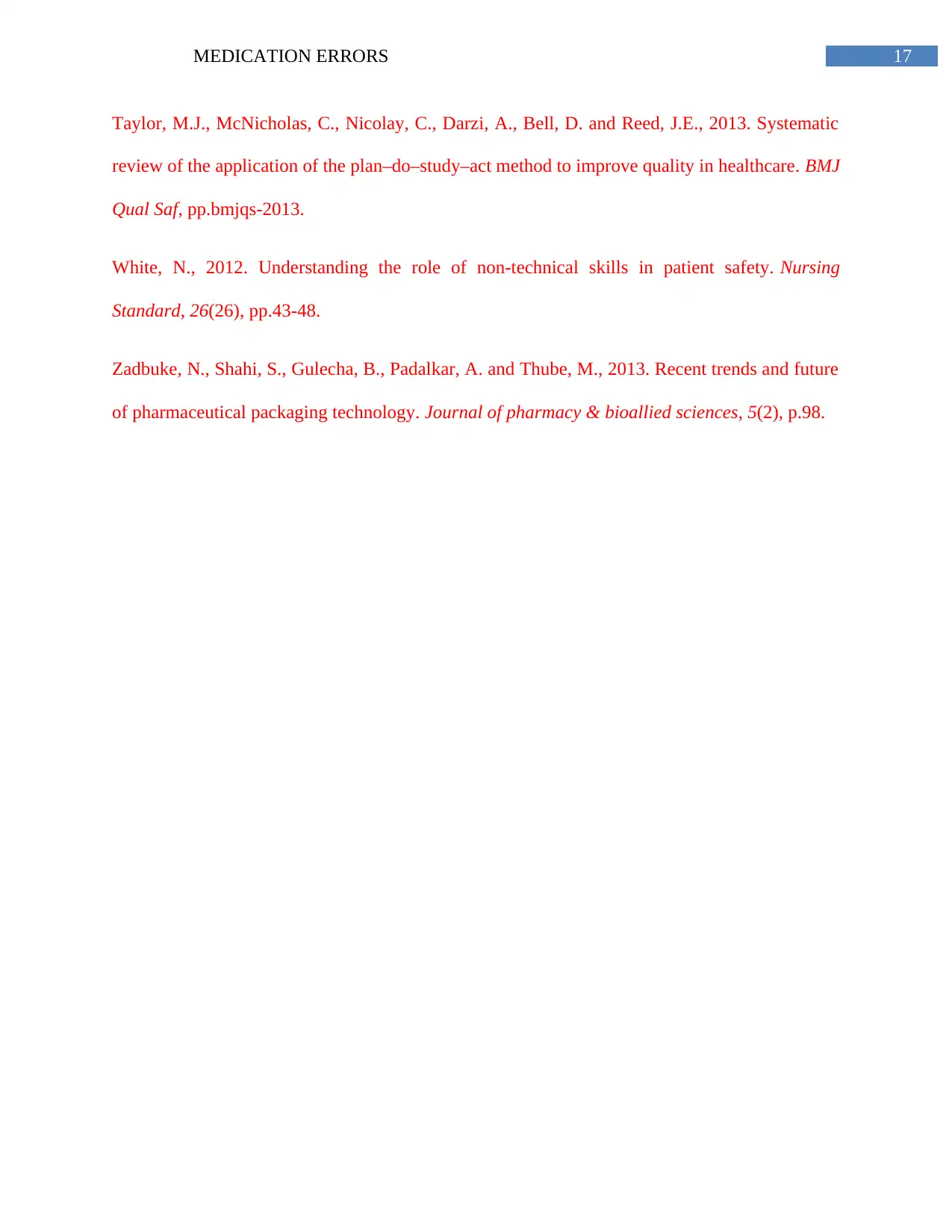
MEDICATION ERRORS 17
Taylor, M.J., McNicholas, C., Nicolay, C., Darzi, A., Bell, D. and Reed, J.E., 2013. Systematic
review of the application of the plan–do–study–act method to improve quality in healthcare. BMJ
Qual Saf, pp.bmjqs-2013.
White, N., 2012. Understanding the role of non-technical skills in patient safety. Nursing
Standard, 26(26), pp.43-48.
Zadbuke, N., Shahi, S., Gulecha, B., Padalkar, A. and Thube, M., 2013. Recent trends and future
of pharmaceutical packaging technology. Journal of pharmacy & bioallied sciences, 5(2), p.98.
Taylor, M.J., McNicholas, C., Nicolay, C., Darzi, A., Bell, D. and Reed, J.E., 2013. Systematic
review of the application of the plan–do–study–act method to improve quality in healthcare. BMJ
Qual Saf, pp.bmjqs-2013.
White, N., 2012. Understanding the role of non-technical skills in patient safety. Nursing
Standard, 26(26), pp.43-48.
Zadbuke, N., Shahi, S., Gulecha, B., Padalkar, A. and Thube, M., 2013. Recent trends and future
of pharmaceutical packaging technology. Journal of pharmacy & bioallied sciences, 5(2), p.98.
1 out of 18
Related Documents
Your All-in-One AI-Powered Toolkit for Academic Success.
+13062052269
info@desklib.com
Available 24*7 on WhatsApp / Email
![[object Object]](/_next/static/media/star-bottom.7253800d.svg)
Unlock your academic potential
© 2024 | Zucol Services PVT LTD | All rights reserved.





